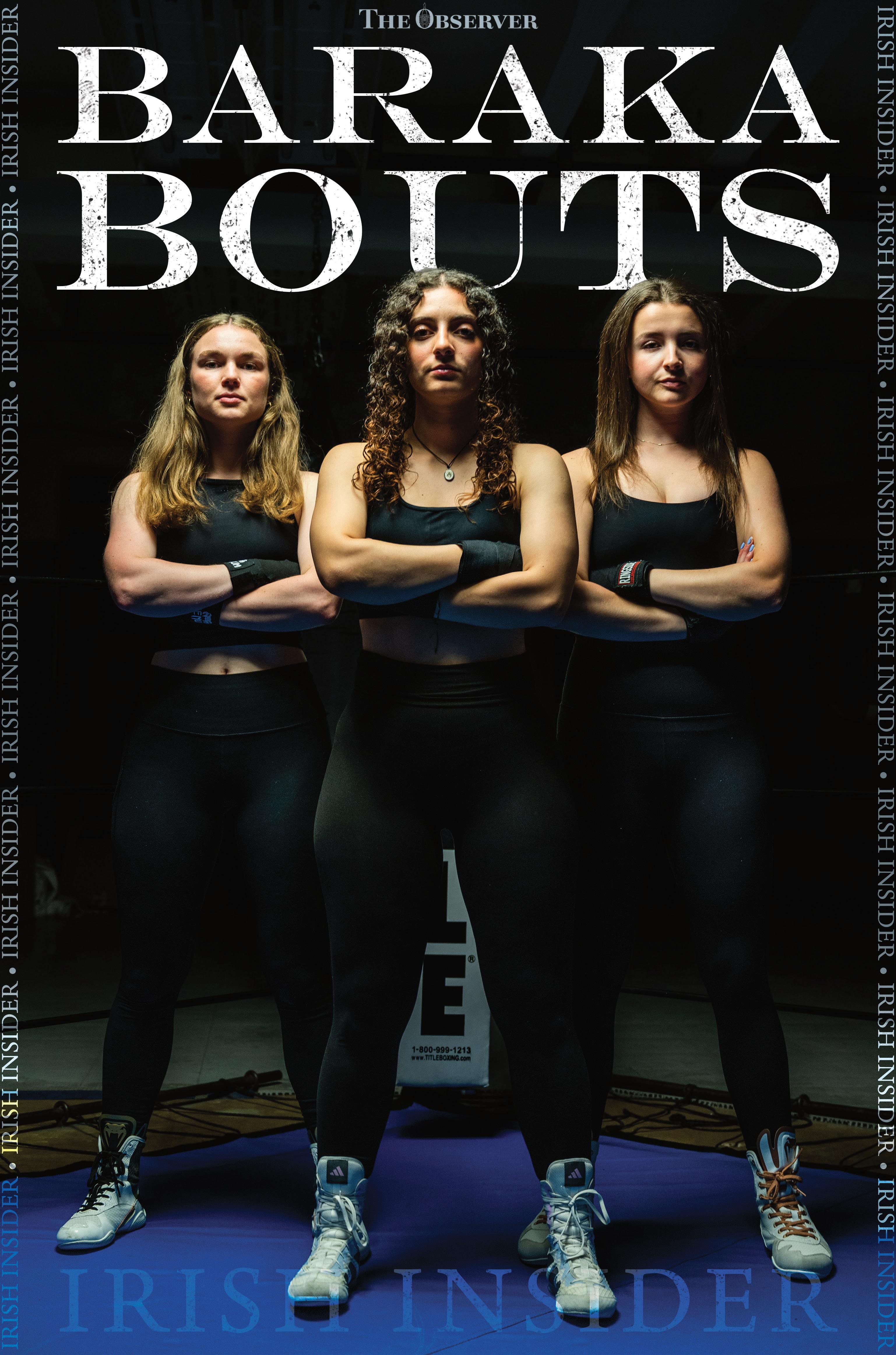

Baraka Bouts is more than boxing for its president
By Noah Cahill Sports Editor
Joining Baraka Bouts was a no-brainer for Layann Wardeh.
She built a connection with combat sports long before setting foot on Notre Dame’s campus. Not wanting to be the odd one out among her kindergarten friends, she
joined a school taekwondo club at the age of four. From there, she fell in love with the sport, practicing it throughout middle and high school.
“That personal work that you have to put in by yourself, there’s a lot of grit,” Wardeh said. “Whenever you are inside the ring, all the work you put in is showcased.”
But while fighters may be
the only ones in the ring when the bell sounds, they are never alone. The relational nature of combat sports is often lost on those who merely see two people trying to knock each other out.
“You get to work as part of a team,” Wardeh said. “You get to learn from so many different people, and that all translates into something between

you and your coach.”
Countless hours of preparation go into fight night. The bonds between athlete and coach, as well as with other athletes training alongside, make those hours fruitful. Mutual respect and support are at the heart of these relationships. Everyone involved knows the courage and willpower it takes to enter the ring. Because of this, they share a common goal: be ready when the moment comes.
As a freshman in college, Wardeh jumped at the chance to keep fighting, this time in the boxing ring. The summer before arriving in South Bend, she stumbled across Instagram posts advertising Baraka Bouts. After talking to the group at the activities fair, she attended their first practice soon after. According to Wardeh, the club and its members made a strong first impression.
“There was one captain, his name was Luke Slahor. He came up to me once and was like, ‘Hey, do you want to get some extra work?’” Wardeh said. “Getting that one-onone work with another captain and seeing how I can improve and progress in the club really kept me in there and kept me working.”
Wardeh soon learned the Baraka community wasn’t just housed within the walls of the pit in the Joyce Center or the tournament ring in the center of Dahnke Ballroom. It reaches far across the globe, specifically to secondary schools in Jinja and Kyarusozi, Uganda. Since its founding in 2002, Baraka Bouts has been as devoted to service and education as they have been to developing fighters. The club raises money for the Holy Cross Missions in East Africa, with this year’s funds being put toward a new girls’ dormitory at the Holy Cross Lake View Senior Secondary School to accommodate more students.
“The fundraising is what kept me there,” Wardeh said. “I went to Uganda between my sophomore and junior year summer through the Institute [for] Social Concerns, so also seeing that has been a reason that keeps me in the club.”
Encountering where all the donations were going in person had a profound impact on Wardeh. In her essay “A Journey of Hope,” which won the 2024 Holy Cross Missions Student Essay Contest, she reflected on her eight weeks in Uganda, where she was touched by the strength and grace of a young girl named Hope. Hope led her netball team through district
competitions, steadying them before the high-stakes game and comforting them after a heartbreaking loss. This inspired Wardeh “to lead with the same confidence and compassion that Hope displayed.”
When she returned to campus her junior year, that’s exactly what she did. Wardeh became the practice captain and, a year later, president of the club. She welcomed the opportunity to mentor people with the experience she had gained over the years.
“Something I really like about leadership positions in general is getting to pass on the knowledge you have to people who are new,” Wardeh said.
She also emphasized the importance of the club’s common goal.
“I think it’s different than a lot of other sports, where the goal at the end is just to win. With our club, it’s also bringing everyone together.”
When she became president, Wardeh had a vision for the club in addition to the continued fundraising efforts. She hoped to instill a mindset in her captains to be voices for the shy, younger athletes. She saw herself in them.
“I’m more on the shy end, or more on the quiet end of people, so I find it hard to approach people sometimes,” Wardeh said. “That’s something I really cared about, having the captains be the people reaching out to other members of the club.”
Wardeh’s approach comes as no surprise. After all, it was her one-on-one with Slahor that helped Baraka Bouts become a part of her life all those years ago. She believes her captains can do the same for any one of the newcomers now.
Wardeh was a born leader. When asked what lights her on fire most, she responded not with fighting nor fundraising.
“I love being in someone’s corner,” Wardeh said. “You get to really tailor a solution to them. It’s not a one-sizefits-all with the people I work with.”
Studying to become a computer engineer, she knows how to problem solve and find the training style that best fits each of her boxers. More than the training, though, she loves to see boxers grow year after year as people and fighters.
“Working with someone is not just boxing … it forms that personal connection that’s way more.”
Contact Noah Cahill at ncahill2@nd.edu
Courtesy of Zoe Keane
Senior Baraka Bouts president, Layann Wardeh, poses in her ring jacket. Wardeh joined Baraka Bouts after a strong initial impression of the club at the activities fair, and has since become a voice for the quiet, young boxers.

THE INDEPENDENT NEWSPAPER SERVING NOTRE DAME, SAINT MARY’S AND HOLY CROSS
WEDNESDAY, NOVEMBER 12, 2025 | VOL. LX, NO. 30
Notre Dame veterans reflect on their service
By Matthew Morin News Writer
Veterans Day, celebrated on Nov. 11, memorializes Armistice Day — the day when World War l ended with a ceasefire in 1918. Each year, the University works to honor veterans’ service and sacrifice with a variety of events.
The Office of Military and Veteran Affairs annually holds Salute to Service Weekend during a home football game weekend. This year, the event was held on Nov. 7 and 8, in conjunction with the Navy game.
The office hosted a pre-game reception for over 400 Notre Dame students, faculty and alumni who are connected to the military. In addition to the reception, admiral Christopher W. Grady ’84 presented a Sojourn 250 flag during the game. According to a University Facebook post, “Several Notre Dame-connected veterans had the honor of holding the flag honoring their service” while on campus.
In addition, the weekend included “live performances of a new song for veterans entitled We All Stand Tall, as well as a live performance of Here Come The Irish,” wrote OMVA director and retired colonel Kenneth Heckel in a statement to The Observer.
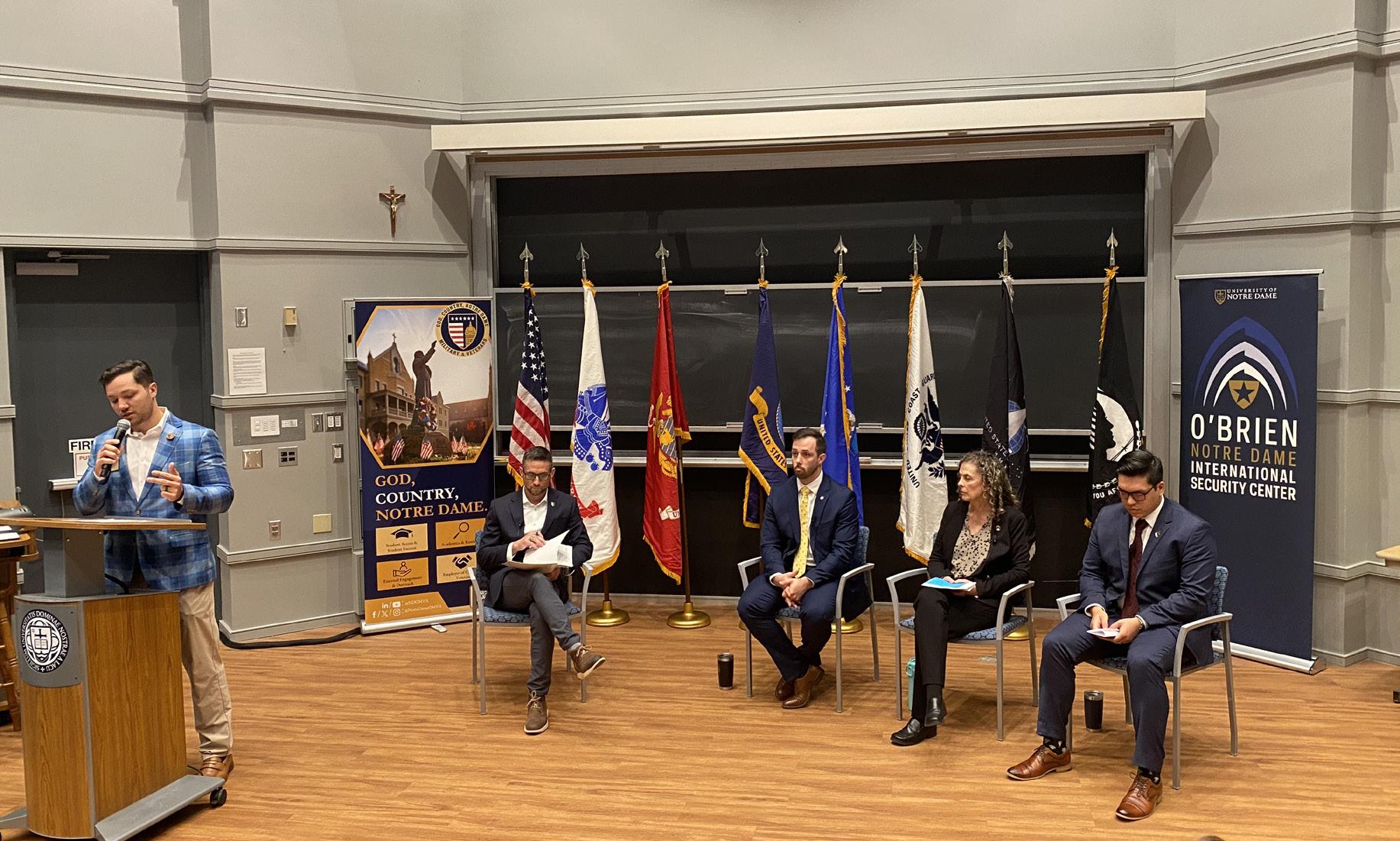
“Both were performed by John Scully ‘80 and Cathy Richardson, who wrote and performed the original ‘Here Come the Irish.’
Our event was recognized by the Alumni Association as the ‘Tailgate of the Week,’” Heckel wrote.
Alongside the Salute to Service Weekend, the University hosted a “What is Veterans Law” panel with law professor Caleb
Stone, a fireside chat with admiral Bill Houston after he visited the the O’Brien Notre Dame International Security Center and the Keough School and a luncheon and and army breakfast with general Bryan Fenton. Additionally, ROTC students were invited to have lunch with Houston and participated in a 24-hour vigil at the Clarke Memorial Fountain. The Mendoza College of Business also
Artist frames Palestine conflict as feminist struggle
By Lucy Loes News Writer
Chicago-based Palestinian artist Mary Hazboun visited Notre Dame on Monday to discuss the intersections of feminism, art and Palestinian liberation for an event called “Palestine is a Feminist Struggle.” Hosted by Student Voices for Palestine (SVP), the evening included the opportunity to meet with Hazboun before her talk, as well as a closing Q&A session.
Although her family immigrated to the U.S. in 2004, Hazboun grew up in Bethlehem, which is part of the West Bank.
She highlighted her Christian Arab identity as often overlooked in discussions of Palestinian people. “I grew up … as an Arab, [and] half Catholic, half
NEWS | PAGE 3
Hesburgh elevators
Facilities staff discuss the reason two of the four elevators in Hesburgh Library are broken.
Eastern Orthodox Christian and Palestinian and under occupation, [which] basically shaped not only my understanding of the world, but also my politics of resistance … I highlight my Christian upbringing to defy the Christian Zionist claims that Palestinian Christians don’t exist, and also that we did, and we do share the reality with our Muslim Palestinian brothers and sisters,” Hazboun said.
On top of those identities, Hazboun emphasized how her experiences living through the “Second Intifada,” a major uprising by Palestinians against Israel, impacted her.
“The second [uprising] was during [my] last year of school. It was probably one of the most horrifying times, not only in history, in the history of Bethlehem, in particular, because that’s when
OPINION | PAGE 5 Off the Dome
Professor Jason Kelly discusses journalism, Notre Dame Magazine and side quests.
the Israeli military invaded the town… that time, being exposed to the military machine firsthand, altered my psyche in ways I still live with to this day,“ Hazboun said.
However, that trauma didn’t manifest itself until after Hazboun had immigrated to America, specifically when she was earning her masters degree in women and gender studies at DePaul University. Her professor, Laila Farah, helped her recognize and work through this trauma.
“That [class was] when all my repressed trauma started surfacing, because of reading course material that discussed military gender and displacement
see “Palestine” on page 2
SCENE | PAGE 7
‘Everybody Scream’ Florence & The Machine’s new alternative rock album is pure cathartic rage.
the panel’s moderators. Beamish came to Notre Dame after serving as a combat controller in the Air Force Special Operations Command. MBA candidate and petty officer first class Rob Parkhurst joined Beamish on the panel, having previously served a decade in the Navy with the Naval Special Warfare Branch. Commander Beth Webber, representing the Inspired Leadership Initiative and the Shaw Center, was the panel’s final moderator. Webber served aboard the U.S.N.S. Comfort as a member of the Navy Nurse Corps. She now works as a consultant for the Shaw Center, “where she helped develop a 10-week mental health and wellness program to support military spouses and build mental health allies within the military community.”
hosted an MBA prospective student veteran visitation day, an opportunity for military candidates to learn about pursuing a business degree.
In addition, the OMVA and the O’Brien Notre Dame International Security Center held a panel titled, “Why I served: A Veterans Panel” on Tuesday afternoon.
Technical sergeant and NDLS 1L Tyler Beamish served as one of
To begin the panel, each participant reflected on the experiences that led them to service. Beamish’s desire for service began in his youth, initially desiring to become a Navy Seal. His call to service solidified after spending two years at Arizona State University. Beamish also recalled the Boston Marathon bombing as an event that compelled him to serve, noting his desire to “be
see “Veterans” on page 3
No update on reported rape
Observer Staff Report
Two weeks ago, campus community members received a crime alert email from the Notre Dame Police Department detailing a reported rape on campus.
NDPD shared that a female victim reported on Tuesday, Oct. 28 that she had been raped in a Jordan Hall of Science bathroom by an unknown perpetrator.
In an email to The Observer Tuesday, university spokesperson Erin Blasko said the University does not have an update on the crime alert at this time.
At the time of the crime alert, the University shared that the suspect was described as male, but no
SPORTS | PAGE 10
Men’s basketball Burton and Towt lead the
further details were available. Notre Dame encouraged community members with knowledge of the reported sexual assault to contact the Office of Institutional Equity at 574-631-0444 or equity@ nd.edu.
NDPD is working alongside the Office of Institutional Equity to address the report. NDPD did not respond to a request for comment on the crime alert.
In April, Blasko wrote in an email to The Observer that NDPD only sends out crime alerts when “there is an ongoing threat to the University community, and the report is sufficiently timely such that a warning will aid in the prevention of similar crimes.”
SPORTS | INSIDER 3
and training.
Ocean Leto feature Baraka Bouts senior captain reflects on the club’s charity, community
Irish to third consecutive win, defeating Eastern Illinois.
MATTHEW MORIN | The Observer
In honor of Veteran’s Day, the Office of Military and Veteran Affairs hosted a panel on Tuesday where three ND veterans spoke about their time in service. Panelists recalled defining moments of their military careers.

ndsmcobserver.com “TO
900
Editor-in-Chief Liam Kelly
Managing Editor Gray Nocjar
Asst. Managing Editor: Aynslee Dellacca
Asst. Managing Editor: Grace Tadajweski
Asst. Managing Editor: Henry Jagodzinski
Notre Dame News Editor: Sophie Hanawalt
SMC News Editor: Berhan Hagezom
Opinion Editor: Redmond Bernhold
Sports Editor: Noah Cahill
Scene Editor: Peter Mikulski
Photo Editor: Mariella Taddonio
Graphics Editor: Isabelle Rutland
Social Media Editor: Duncan Stangel
Ad Design Manager: Isabelle Rutland
Business Manager: Zack Pohlman
Systems Administrator: Jack MapelLentz
Advertising advertising@ndsmcobserver.com
Editor-in-Chief lkelly8@nd.edu
Managing Editor gnocjar@nd.edu
Assistant Managing Editors adellacca01@saintmarys.edu, gtadajwe@nd.edu, hjagodzi@nd.edu
Business Manager zpohlma2@nd.edu
Notre Dame News Desk
shanawal@nd.edu
Saint Mary’s News Desk
bhagezom01@saintmarys.edu
Opinion Desk rbernho2@nd.edu
Sports Desk ncahill2@nd.edu
Scene Desk pmikulsk@nd.edu
Photo
Systems
webmaster@ndsmcobserver.com
Policies The
Holy Cross College. Editorial content, including advertisements, is not governed by policies of the administration of any institution. The Observer reserves the right to refuse advertisements based on content. The news is reported as accurately and objectively as possible. Unsigned editorials represent the opinion of the majority of the Editor-in-Chief, Managing Editor, Assistant Managing Editors and department editors. Commentaries, letters and columns present the views of the authors and not necessarily those of The Observer. Opinion space is available to all readers. The
$15 million gift funds veteran scholarship
Observer Staff Report
A $15 million gift from Bill Angrick ‘90 and Stephanie Angrick has enabled the creation of the Angrick Military Scholars program, which will support up to 10 military-affiliated students and families in the Mendoza College of Business’ full-time MBA program.
“The University of Notre Dame is further strengthening its long-standing and deeply rooted commitment to supporting active-duty service members and veterans with the launch of the Angrick Military Scholars Program,” the University press release reads.
Angrick Military Scholars will primarily consist of U.S.
Palestine
Continued from page 1
violence … So what I was feeling somatically in my body, having to leave the classroom because of post trauma symptoms. It got to a point where I was like,
‘I don’t think I’m going to finish this program because I feel like I’m dying.’ So [Farah] said… ‘you’re going to go through hell, but I’m going to be there with you every step of the way,’” Hazboun said.
During her studies under Farah, Hazboun discovered that art could be both a way to escape and process her experiences. This unique purpose emerged in her style, which features cramped, minimalistic figures to represent the way women’s bodies have been controlled. This style eventually became part of her masters thesis.
“I remember events and fragments, which echo in my work
military veterans and Coast Guard veterans enrolling in the MBA program, with preference going to those with families.
”By expanding access to a Notre Dame education for militaryaffiliated students, we honor the extraordinary sacrifice of these students and their families and prepare them to be exceptional leaders in their chosen fields. At the same time, our campus community is immeasurably enriched by their presence and by their example of dedication to our nation and to the common good,” University President Fr. Robert Dowd said in the press release.
The scholars will receive $30,000 per year, which can be used to cover expenses such as tuition, housing and childcare.
in the minimalist style, and then you would see a part of a story, or maybe a scene in an event, but you don’t see everything else. That’s how I remember my life. The brain does that for protection,” Hazboun said.
For Hazboun, the purpose of her art is to make the experiences and trauma of women in Palestine visible and exigent.
“My work is unapologetically about grief. It is about showing a visual of what trauma would look like if it was visible.” Hazboun said.
Hazboun emphasized her intention is to show how Palestinian feminism is not a single-issue topic. Instead, she believes it’s intertwined with issues of colonialism, racism and militarism and is far more complex than the stereotypical notions of Western feminism.
Alice Lei, a member of SVP who organized this event, highlighted how Hazboun’s art disrupts ideas of a universal, one-size-fits-all feminism.
“What especially stood out to me was [how Hazboun was] shedding
According to the press release, this funding is in addition to any merit-based or any other financial awards the scholars may also receive.
One or more scholar per year will be additionally recognized for their achievements and alignment with Notre Dame’s mission by being named a Naticchia Fellow, named after Stephanie Angrick’s late father, a Marine Corps veteran.
Martijn Cremers, the Martin J. Gillen dean of the Mendoza College of Business, said in the press release the gift will enable the Notre Dame MBA program to offer “the most comprehensive financial support available to families of qualified military students.” He added the program will allow
light on the Palestinian women’s movement and rejecting the notion that liberal white feminism must be the dominating, patronizing force that speaks for and over women of the Global South, women of color, the queer community and the subaltern,” Lei said.
Lei stressed the difficulty in getting the University to allow events like this to be held on campus, particularly after the pro-Palestinian protests two years ago, in which multiple students were arrested.
“My sophomore year, and I’m a senior now, students were arrested for demonstrating, and this is a memory that is effectively erased from this campus. I don’t see a lot of people talking about it. People don’t really know about mobilization at Notre Dame, [since] it is difficult for us to even get a guest speaker here, because they think it’s too political, or they think it’s going to instigate something,” Lei said.
For Lei, art is an alternative form of resistance and a “subtle way of navigating” around this
Notre Dame to attract military and veteran leaders.
Echoing this statement, Kenneth Heckel, director of the Office of Military and Veterans Affairs said in the press release that, “The Angrick family’s transformational gift will ensure that Notre Dame is the premier institution for military leaders who embody high moral character, outstanding leadership and love of country for years to come.”
The Angricks have previously donated to the University, contributing to endow the Stayer Center’s executive lounge and offices as well as internships for Notre Dame’s ESTEEM graduate program. Bill Angrick is a member of the Mendoza Business Advisory Council.
difficulty.
“We are still resisting in ways that, maybe under the University’s radar, can be conceived of as less dangerous than a protest or a gathering of students, but still finding ways to insert this dialogue on campus and make sure that these communities of students in this room and faculty and so many people [are] not forgotten,” Lei said.
Despite the current situation in Palestine and the ways people remain hesitant to discuss it, Rebecca Holm, a senior at Saint Mary’s, said Hazboun’s talk gave her hope.
“There’s so much hope in the world, even when it’s difficult to think like that, because ‘Oh, nobody believes it.’ But then you have such a huge turnout here ... and you’re like, ‘Wow, there is a community that is paying attention to this,’ and that’s really beautiful,“ Holm said.
Contact Lucy Loes at lloes@nd.edu
Staff
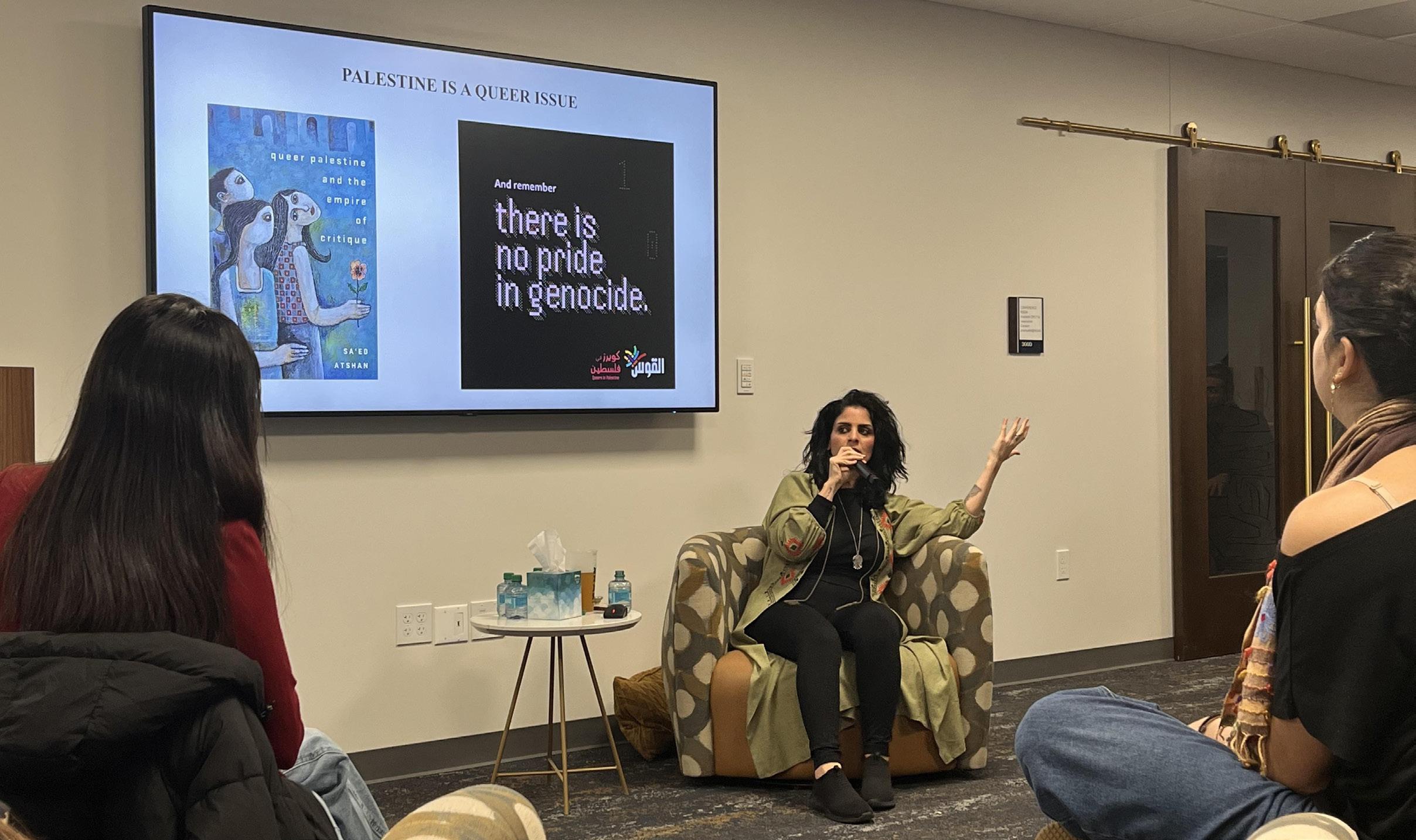
LUCY LOES | The Observer
Palestinian artist Mary Hazboun speaks to students on Monday about how the Palestinian conflict isn’t a single-issue problem, but is rooted in feminism, colonialism and queer rights. She recalled growing up in Bethlehem and spoke about how her repressed trauma influences
Hesburgh elevators break, causing disruption
By Mara Hall News Writer
Two of the four passenger elevators in Hesburgh library are out of service, having “suffered driver failures,” according to a statement university spokesperson Erin Blasko sent to The Observer on Tuesday.
Facilities program director Reginald Burton explained the drivers “capture the energy from the motor when the elevator breaks or slows down.” According to Burton, these drivers feed the energy “back into this power grip that is in the elevator and that is what makes the elevator work.”
Blasko said the drivers were sent out for repair. The university expects to see one back as early as tomorrow, while the other should arrive early next week.
“It should take an hour or two to install each of the drivers once they arrive. In the meantime, the other two passenger elevators remain in operation,” Blasko wrote.
Margaret Meserve, vice president and associate provost for academic space and the interim Edward H. Arnold dean of Hesburgh Libraries and University of Notre Dame Press, explained that this is an issue that happens
Veterans
Continued from page 1
the person, who when the time comes, [can] act.” Like Beamish, Parkhurst enlisted in the Navy after spending two years in college.
Webber’s ‘why’ began with growing up as a third generation Navy family member, explaining that her family’s service gave her a sense of duty. All three panelists stayed in the military beyond their first term of service, and Webber noted that part of her reason for staying in the military was the lifelong learning it provided.
Each of the panelists was then asked to described a defining moment from their years in service.
For Webber, this moment was a trip to New York City following 9/11, when her mission was to provide health care and mental support.
Parkhurst noted that his defining moments stemmed from finding humor in humorless situations.
Beamish echoed Parkhurst’s words, recalling an experience from “hell week,” which he described as “five days of very little sleep, living on your feet with a 60-pound rock on your back.” He continued, “It was 30 degrees out, raining in North Carolina. We had lost half of our class already, and we were in the middle of a rock. And one of my buddies just goes, this sucks. All of us started
occasionally.
Despite regular maintenance, “each elevator has a number of these parts, and they fail from time to time,” Meserve said. “We are just, at the moment, in an unfortunate situation where the drivers on two of the cars have failed at the same time.”
The delay stems from the lengthy process of replacing parts.
“We are waiting for parts. The parts for these things are very, very expensive and you have to send them out. Once you send them out, you have to wait until they send them back. We have to send the parts all the way to Virginia so they can be rebuilt and then once rebuilt they have to send them back,” Burton said.
The company in Virginia who fixes the parts also outsources parts from another company. In this instance, the parts from the third company are causing the delay.
While no one was able to provide a clear answer on when these elevators were installed, Meserve explained that the library was built in 1963 and has since undergone a significant renovation beginning about a decade ago.
She believes the elevators were overhauled during the renovation.
Along with the four
laughing. All of us were so tired. It was so comical, just so simple.”
Webber also spoke about her unique experience as both a veteran and a military wife, as her husband continued to serve after she retired.
“I would have to say that the job or the role of a military spouse or a military family member is the hardest ... It’s challenging to send them away, to send them away to Afghanistan and not know what’s going to happen.”
To the extent of leaving the military, Webber said, “Eventually you take off your uniform and all your medals and ribbons, but it’s the impact that you left on their soul. I always call it leaving fingerprints on the souls of others.”
The panelists commented on the difficult transition from military to civilian life.
“You’re part of a team and then you’re not on the team, and you miss it,” Webber said.
When asked how to bridge the divide between military and civilian life, Parkhurst asked audience members to remember “Every veteran is just like you.”
He also noted how Notre Dame has eased this transition, saying, “The University has the best veteran network, not just for getting you a job or for helping introduce you to somebody else, but they hold the values of the University.”
In response to positive feedback from veterans like Parkhurst, OMVA is expanding programs

passenger elevators, Burton shared the library also has a fifth freight elevator.
“Here in the library we have five [elevators]. We have those four, and we have a freight elevator that goes from the basement to the second floor. It is a bigger elevator and that one was actually less than two years old,” Burton said.
According to Meserve, the university complies with ADA regulations by having elevators carry people to and
that assist veterans, including “exploring ideas to create an undergraduate student veteran fellows program, which will include an array of initiatives and services for our fellows, in collaboration with the University Counseling Center, the McDonald Center for Health & Wellness, the Meruelo Family Center for Career Development, and several other partners,” Heckel wrote.
In addition to the fellows program, Heckel explained that the office is piloting a faith-based retreat in collaboration with Campus Ministry, “where up to 6 of our student veterans will travel
from the public floors.
“We also have stairs that people can take to every floor, but the elevators are certainly a crucial part of the operation of the building,” she said.
Both Meserve and Burton say they’ve noticed longer waits for the elevators, especially during the recent home football game.
“We don’t really have a way of tracking [elevator wait times], although I would say observationally, I have seen more people waiting in the
to Italy for a pilgrimage that retraces the journey of St. Francis of Assisi.”
The O’Brien Notre Dame International Security Center also offers programs to assist veterans, including a “a three-year PhD. Program for active duty officers from Air Force, Army, and Marines. We’d welcome Navy and Space Force as well … The military and civilian students are both vital parts of our program,” professor Michael Desch wrote in a statement to The Observer.
Desch continued, “Through training the next generations of leaders in national security, we
elevator lobby. Certainly on game day, their visitors come into the library and they like to go up to the upper floors to see the view, and there were some crowds of people waiting around there. I have not seen the same crowds during the week, so my very unscientific sense is that it has not created an undue burden on people waiting to get into the elevators,” Meserve said.
Contact Mara Hall at mhall27@nd.edu
honor soldiers, sailors, etc. by ensuring that civilian leaders understand when and how our military can be used most effectively to ensure our nation’s security. We believe that supporting the troops means asking them to go in harm’s way only when it is in our nation’s vital interest.”
Professor Ian Johnson echoed Desch’s words, writing that these programs are urgent projects “In a society like ours, where civilians ultimately decide the key questions of national security.”
Contact Matthew Morin at mmorin2@nd.edu
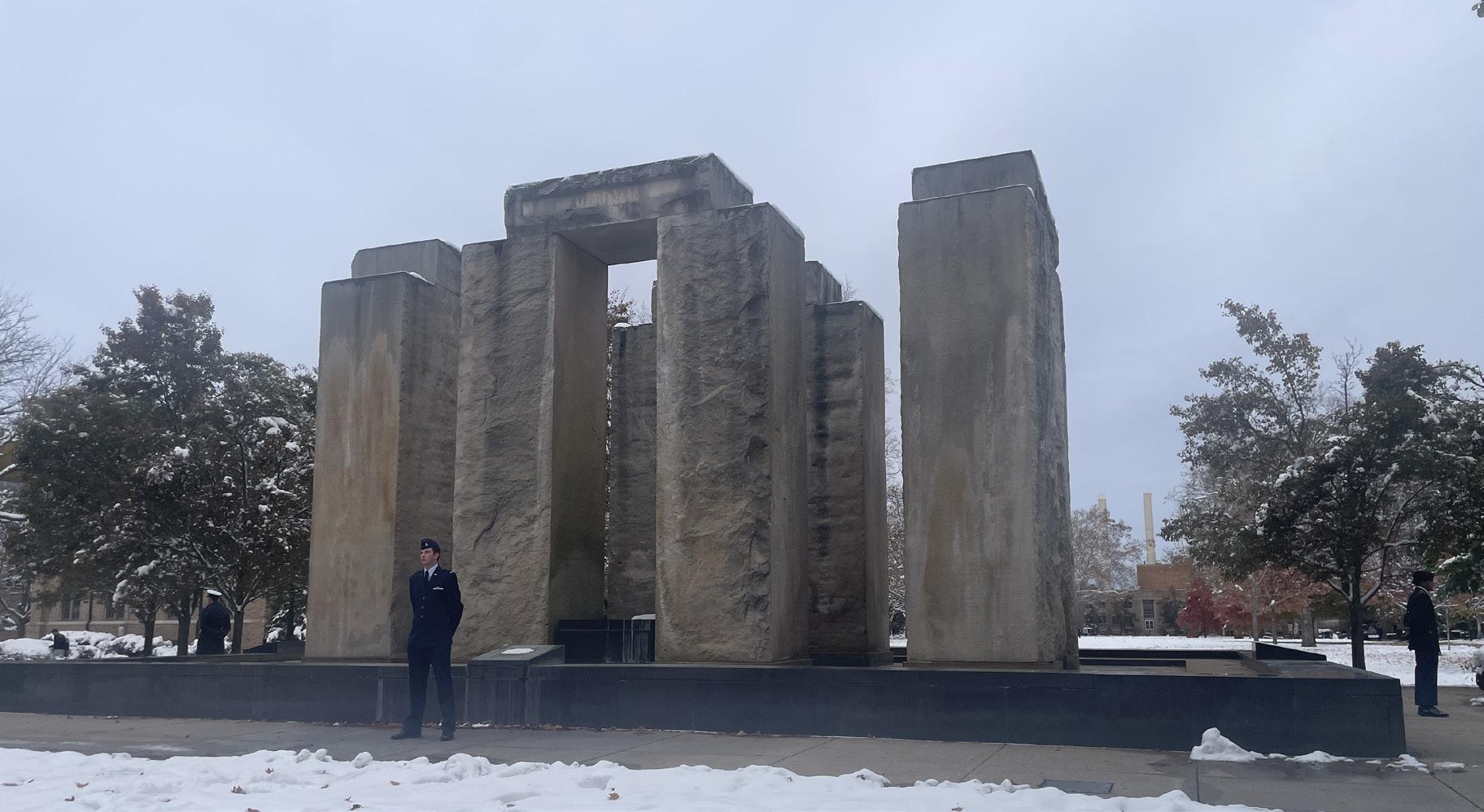
MARA HALL | The Observer
Two of the four passenger elevators in the Hesburgh Library are broken due to internal driver malfunctioning, according to facilities staff. This delay is due to a complicated process for obtaining replacement parts.
GRAY NOCJAR | The Observer
(‘87).
THE ti)BSERVER

Develop your journalism, photography, and des ign s kills Contribute to o u r mission and serve the tri-campus community

By Allison Elshoff Columnist, “Off the Dome”
For someone who spends a lot of time interviewing others, professor Jason Kelly recoils at suddenly being the one questioned. “I like being on the other side of this,” he laughed.
Professor Kelly serves as editor of Notre Dame Magazine, which has covered the University and topics of importance to alumni since the magazine’s founding in 1972. It’s very full-circle work for the South Bend native and Notre Dame alum: “I’ve read the magazine since I was a kid,” he explained. “I really can sort of remember it sitting on my dad’s desk … it’s cool to be able to contribute to it before I worked here, and then come back here to work.”
I had thumbed through the magazine’s latest issue, titled “The Intellectual Life of Alasdair MacIntyre,” while waiting outside Professor Kelly’s office that morning. From a think piece on Korean identity to a feature on a Chicago-based rock band named Ratboys, one can open to any page of the magazine and learn something new. It’s this form of constant discovery that Kelly loves about his line of work. “There’s just a lot of interesting people and interesting issues out there that are sort of inexhaustible,” he says. While it may be impossible to become an expert on every topic he’s interested in, being a journalist gets him close. “I think I wouldn’t have been
Off the Dome: Jason Kelly
good in any sort of like serious, deep academic research world where you’re kind of going very deep into one thing. I like the kind of mile-wide, inch-deep version.”
As the head of the Gallivan Program in Journalism, Ethics, and Democracy (JED) on campus, Kelly hopes to give students the tools they need to learn about the world in this way, too. The program offers a minor for students interested in working in news, requiring coursework in the study of reporting and editing, as well as a professional news internship.
“[The program] is very intentionally a minor, you know, no aspirations to be a major,” the journalism professor explained. “It is meant to sort of fit into that larger picture of whatever education you’re getting here at Notre Dame, whatever discipline you’re interested in, and then get the skills in the journalism minor[so] that you can apply that knowledge and help people understand the world better.”
This kind of flexibility is the beauty of the JED minor. Serving as a supplement to students’ overall education, it allows for space to both figuratively – and literally – do the type of wandering inherent to journalism: pursuing the world’s curiosities and being open to follow where a story might take you.
It’s this type of free wandering that, unfortunately, many students often don’t allow in their schedules. “I get that there often feels like there’s
no time or no energy for this stuff, because you guys are so busy and so full of demands … [but] there’s something to be said for kind of just getting lost in something or just getting lost and following your gut.”
As a business major, I’ve seen firsthand the careerism that stops Notre Dame students from letting themselves get lost. Claiming to need a practical major or recruiting for an internship just because everyone else is, results-oriented students often flock together, finding safety in numbers while cutting themselves off from exploring their own unique interests. Anything that doesn’t have immediate, external utility is viewed by many at the University as a waste of time.
When I ask what the journalism professor would tell these students given the chance, he – in true journalist fashion – flipped the question on me. “You’re closer to the ground than I am,” he laughed. “So help me – what would you tell them?”
I told him about how much I’ve enjoyed writing for The Observer for the past three years, and how it has allowed me to pursue a side quest outside of my major. I use the term side quest to refer to anything seemingly random pursued out of one’s own pure interest and enjoyment. Even though you won’t find writing for the Observer on my official transcript, it’s brought me more fulfillment than many of the required things I’ve done for credit at the University.
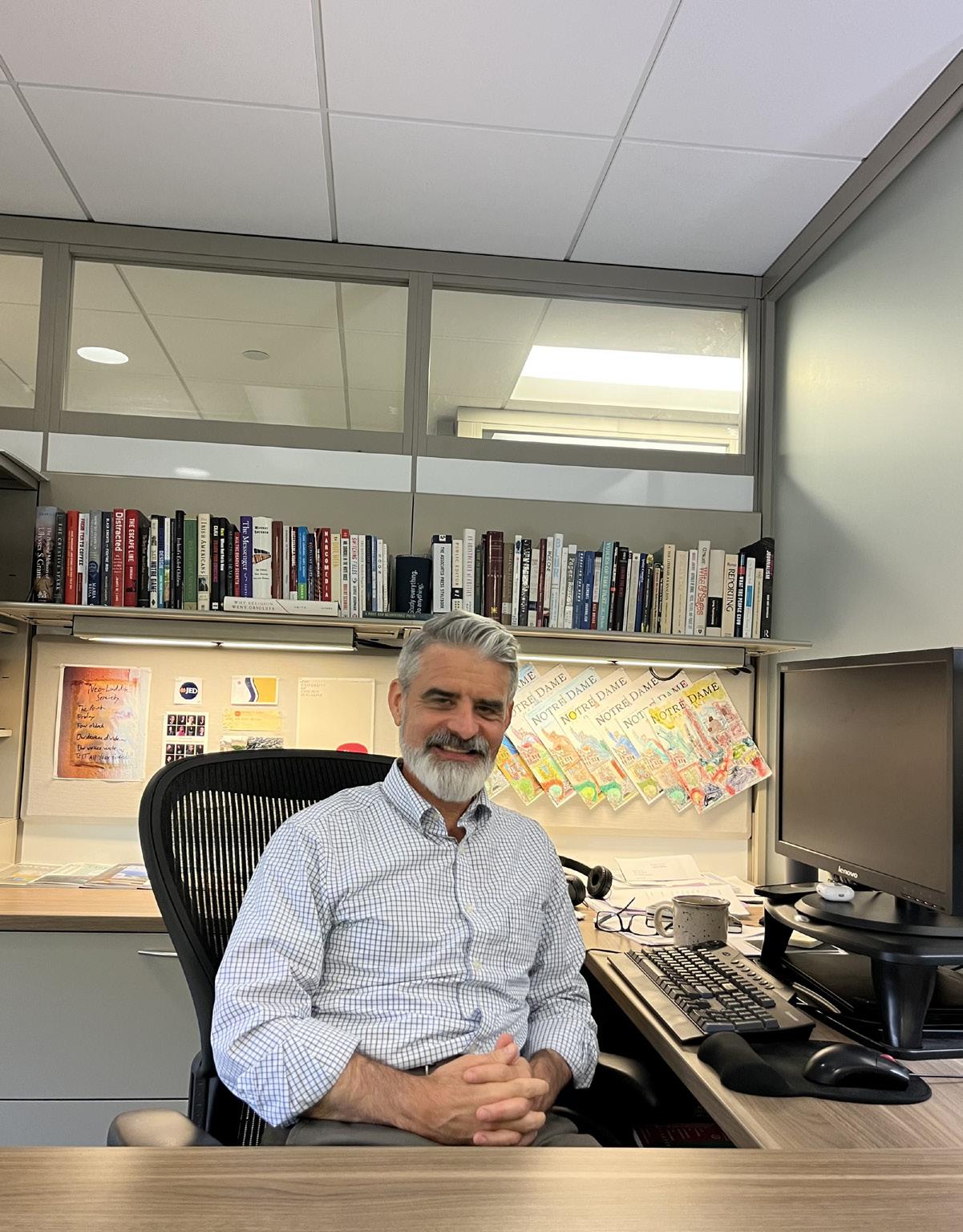
“So that’s my answer,” he said. “Find the side quests. [They] might lead you somewhere that actually does count.”
Maybe that’s why I prioritize this series so much — each interview is its own kind of side quest, an excuse to get lost in someone else’s story. Kelly agreed. “It’s a real luxury to be able to, you know, more or less, knock on somebody’s door and say: ‘Hey, can I ask you a bunch of questions?’”
I’m lucky to have enjoyed
this luxury for an hour with Kelly. He’s nailed exactly why I love writing this column: to knock on the doors of interesting people like him, and ask them a bunch of questions. Even if – actually, especially if – it counts for zero credit.
The views expressed in this column are those of the author and not necessarily those of The Observer.
Contact Allison Elshoff at aelshoff@nd.edu
The joy of knowing: intellectual life at Notre Dame
By Richard Taylor
What does an “intellectual life” look like at Notre Dame? How do we students live a life devoted to learning and truth in the midst of a demanding course load, a chaotic schedule, a vibrant social life and professional pressures to succeed and to achieve?
I am not the only one asking these questions.
Notre Dame senior Erica Dowd recently wrote an article titled “Leave learning alone,” in which she expresses the idea that “the value of learning is not compromised” in the modern university. Dowd’s article expresses the conflict between the practicality of getting a degree to get a job and the ideal of living the intellectual life at Notre Dame.
Saint Mary’s freshman Sienna Stephens recently wrote an article titled, “Spend
more time alone,” in which she articulates the value of solitude in a campus culture that tends to view alone time as “being on the sidelines.” Stephens’ article expresses the conflict between living a bustling social life and living a quiet, contemplative, intellectual life in this tri-campus community.
English graduate student Oliver Ortega recently wrote an article titled, “In the trenches: surviving Hesburgh Library’s dissertation boot camp,” in which he reflects on the grueling process of writing his dissertation and wonders, “Was it intellectual curiosity or intellectual masochism that put me on the Ph.D. path?” Ortega’s article expresses the conflict between living the disciplined and highly structured “academic life” with living the free and creative intellectual life at Notre Dame. Professor of philosophy
Paul Blaschko recently wrote an article titled, “Creating a Culture of Virtuous Leisure in a World of Total Work,” in which he attempts to answer the question (originally posed by one of his students), “What does leisure look like today?” Blaschko notes that many of the models of living an intellectual life (or a life that cultivates “virtuous leisure”) are outdated and not suitable for Notre Dame’s environment (e.g., “ancient symposia, 18th-century salons, or even monastic rules of life”). Blaschko then describes Notre Dame’s Sheedy Family Program in Economy, Enterprise and Society, which explores the relationship between business and the liberal arts, as a community and a curriculum at Notre Dame that successfully cultivates virtuous leisure. For Blaschko, the program — with its “competitions, academic workshops,
and lightly structured latenight dialogues around a campfire on the shores of Lake Michigan” and its “three-hour dialogues over dinner each month in a room that looks like we’re on the set for ‘Harry Potter’ or ‘Downton Abbey’” — successfully “integrate[s] the life action with the life of contemplation through dialogue.”
I do not think Blaschko’s answer is quite right. A community and curriculum like the Sheedy Family Program may succeed in dissolving the conflict between practicality and liberality expressed by Dowd by integrating business and the liberal arts. It may succeed in dissolving the conflict between gregariousness and solitude expressed by Stephens by promoting independent learning integrated with communal discussion. It may succeed in avoiding the conflict between the grueling labors of academic
life and the curiosity and creativity of intellectual life expressed by Ortega. It may succeed in creating a culture (albeit a small and exclusive one), but it is ultimately not up to culture to foster the intellectual life. The more the Notre Dame student relies on programs, curricula and, to some extent, even communities to structure his or her intellectual life, the more the student will fail to develop the personal habits necessary to live an intellectual life. In one of my classes, we recently discussed a classic book on this subject, “The Intellectual Life” by French Dominican A.G. Sertillanges (1863-1948). The angle which my professor and many of the students took was that Notre Dame needs to ease off its rigorous academic requirements and work toward fostering a culture of leisure.
see “Leisure” on page 6
Columnist, “Just Glad To Be Here”
ALLISON ELSHOFF | The Observer Professor Jason Kelly serves as Notre Dame Magazine editor and the head of Gallivan Program in Journalism, Ethics, and Democracy.
Leisure
Continued from page 5
Sounds good to me. But in my opinion, so long as we students look to Notre Dame to live the intellectual life for us, we will fail to live it ourselves. We cannot live the intellectual life by adding another minor, by applying for another major or by joining another club. Neither do we need to engage in more “academic workshops” or dine in “a room that looks like we’re on the set for ‘Harry Potter’ or ‘Downton Abbey.’” We only need to, after a long day of coursework, in the silence of our own cinderblock dorm rooms at our reused desks, take a peek inside a worn-out library book for no other purpose than to satisfy our curiosity. We only need to, on the walk between classes, jot down a note on a cracked iPhone screen of an interesting thought we
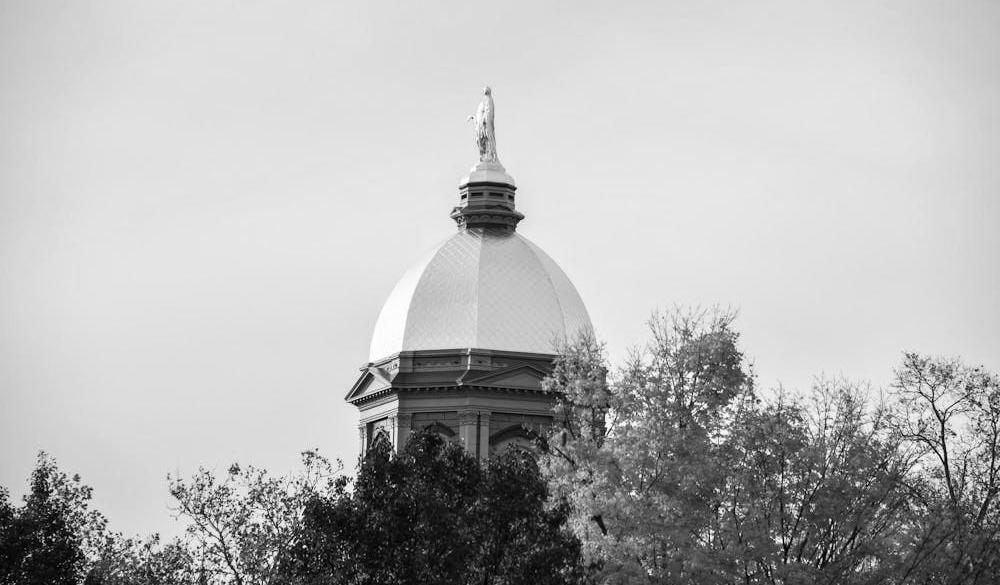
Located at the center of campus, the building serves as a symbol of the University, both on campus and for the outside world.
just had or admire through smudged glasses the sun shining through colorful autumn leaves. We only need
to, while getting lunch with a friend and overheating in South Dining Hall, raise a question about the faith or the economy
(or even some other far more trivial topic) and stumble together toward an answer. The pedagogue has the
You are (en)titled to nothing
In early September, I found myself sitting on a highchair in a packed Duncan classroom, helping lead a community kickoff for an oncampus organization I am a part of. I was drenched in sweat; I had forgotten my new nametag, which I was supposed to wear, and was forced to run-walk to my dorm and back to retrieve the item before the event officially started. I took my seat, evidently breathing heavily and perspiring (like a maniac), and began to gaze out at the crowd. To my great dismay, I saw many familiar faces — some greeted me with a kind smile and nod, while others wore a solemn expression, thinly veiled with the same worry I carried on my face.
The event ran its course, and at the end, there was an invitation to “meet” and “network” with board members of the organization I was a part of. As a board member, I stayed behind to meet those who wished to speak to us. This action, for some reason, struck me as unusual. I answered eager questions about career paths and networking, trying to sound composed — yet the idea that my words carried weight, that my advice mattered, felt strangely undeserved. My title as a board member placed me in that position. People approached me with questions about their futures because, of course, a board member would know. Repeatedly, I thought to myself, “I am not this important.” I couldn’t help but wonder if the value of my words was solely attached to my title, rather
than the person speaking them. Titles are something we all carry — son, daughter, brother, so on and so forth. Some of these titles take a more formal nature: director, co-president, club officer, board member. Our innate, familial titles will never leave us, no matter what lengths one goes to distance themself. However, earned titles — gained through climbing the metaphorical ladder of an often-self-engineered bureaucracy — come and go as they please. In my life, I have been a “committee member,” a “secretary” and I even rose the ranks to the esteemed role of a “vice president.” These titles, although important, no longer hold bearing on my life. I will always be a brother, but there will be a day when the board I serve no longer requires my presence.
However, the value of earned, artificial titles often supersedes our most basic ones. People seek higher titles as a means of differentiating themselves from the herd. I find this to be the greatest danger of titles: We understand them to be the origin of our importance. As outsiders, we elevate the “president” of a club above the “vice president” or “director,” even when they leave the spaces where those titles hold any weight. Understandably, it is difficult not to internalize that hierarchy ourselves. We should be proud of what we accomplish, but once our sense of self becomes contaminated by external distinctions, we begin to lose the true essence of our importance. It is not the title that holds the value; it is the person who bears it.
impossible task of getting students to do something only they can do for themselves. Designing programs and curricula to create a culture that fosters the intellectual life at Notre Dame is a noble endeavor which addresses a real problem with our current “achievement” culture. But this is a cultural change which can only really be affected from the bottom up — from the free wills of curious individuals choosing to value truth, because of the joy of knowing, in the leftover time in their schedules and in the conversations with their friends.
The views expressed in this column are those of the author and not necessarily those of The Observer.
Contact Richard Taylor at rtaylo23@nd.edu
The honor in wearing the badge of a “board member” or “club officer” lies in how it reflects on your Godgiven abilities and willingness to serve. Our nature cannot be confined to a few words on a resume, nor our worth measured by the titles that follow our names. As we grow older, and “club officer” becomes “Dr.” and “board member” becomes “partner,” we must not lose sight of the title that gives meaning to all the rest — the simple, enduring one of being human.
The views expressed in this column are those of the author and not necessarily those of The Observer.
Contact Naasei Lynn at wlynn@nd.edu

MARIELLA TADDONIO | The Observer
The University of Notre Dame’s Golden Dome shines against a gray Indiana sky.
By Naasei Lynn Columnist, “The Oregon Tale”
‘Everybody Scream’: a raw reflection on trauma
By Natalie Swiderski Scene Writer
Florence Welch’s alternative rock/pop group, Florence + The Machine, recently released their sixth studio album titled “Everybody Scream,” a 12-track, 49-minute collection of pure cathartic rage. Stemming from and seeded in Welch’s personal experience with her physical and mental wounds following a miscarriage and the relation of this tragedy with northern European folklore and horror, the album is visceral, haunting and chock-full of angst and rage.
This work marks a shift in the band’s general focus and artistic priorities. One of the group’s most prominent collaborations of late entailed a track with Taylor Swift on her “Tortured Poets Department” album, a strange, neogothic song of the Lana Del Rey-esque genre, reflecting on the “beauty” of the state of Florida. Fans like myself were left more confused than delighted by the song, so I, for one, am glad Florence + The Machine has returned to their own musical style.
“Everybody Scream” brings the band back to its familiar, much-cherished sound of heavy drums and impassioned vocals. Though every song deserves a listen, a few stand out
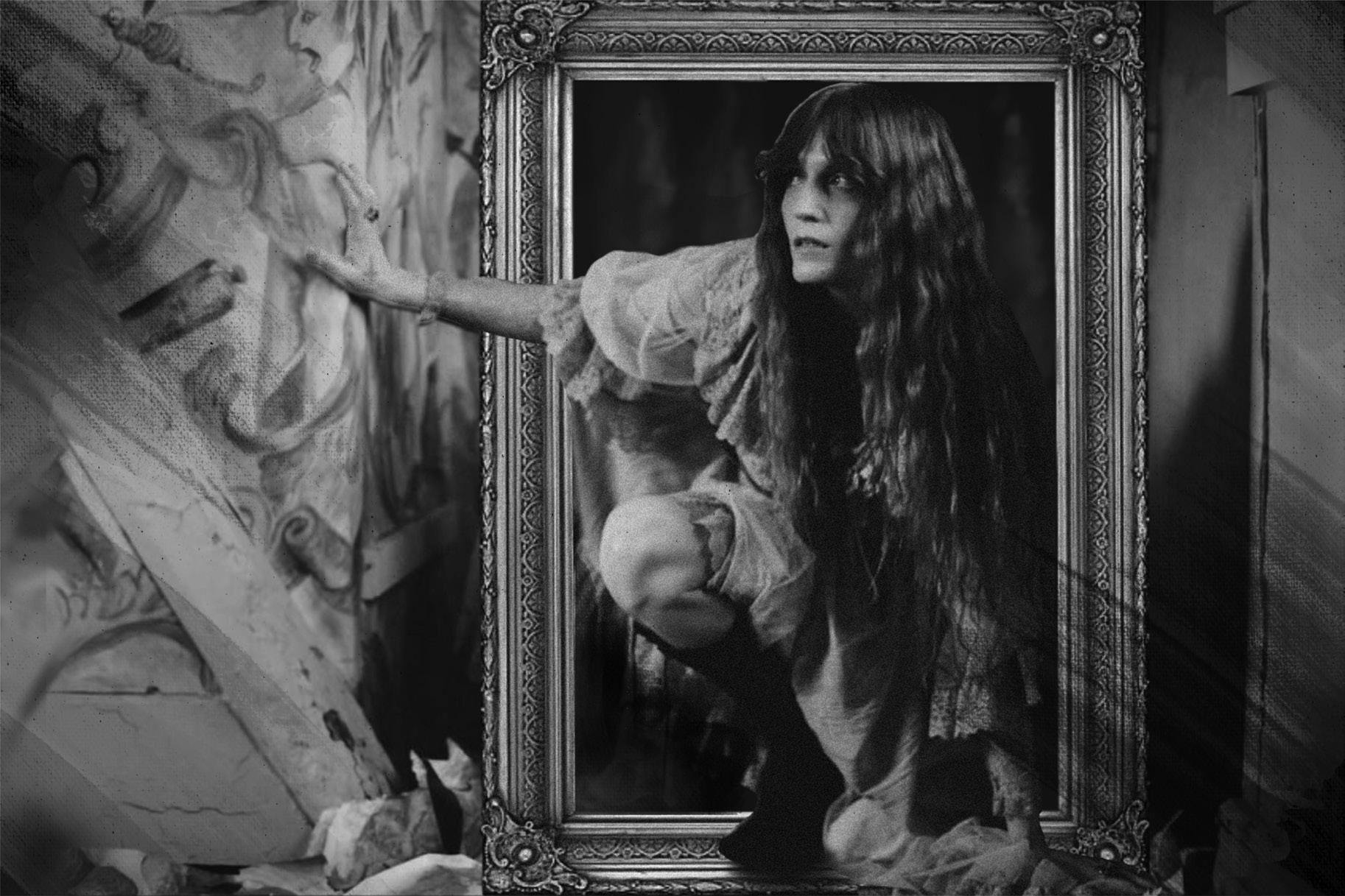
trend to be single, wouldn’t you be tired too?
“You Can Have It All”
further than the rest.
“Buckle”
Despite Welch’s overall commitment to the theme of rage expression and feminine autonomy in this album, Welch channels her inner Julia Roberts of “Notting Hill” in “Buckle.” Believe it or not, she just wants to be loved, too. With the soft strum of an acoustic guitar and a faint symphony of backing vocals, Welch delivers a quietly heart-wrenching reflection on the tragedy of unrequited love. With painfully relevant and certainly relatable subject matter, this track is sure
the sad spiral of a hopeless romantic’s woes come Valentine’s Day.
“Kraken”
In “Kraken,” Welch finally comes to terms with fame. In interviews, she has noted that she finds fame strange and does not relish being the center of attention. This is not the case anymore. In this song, she personifies the Scandinavian folklore monster, the Kraken, presenting strength and resistance to anyone who dares call themselves a hater. She further develops this concept
with sharp, hasty vocals and a punchy backing beat. In “Kraken,” Welch maintains her identity as a force of nature.
“Music by Men”
A darkly somber and lyrically ballad-like song, “Music by Men,” explores Welch’s frustration with modern dating. Her voice is ominously soft, a sharp contrast from her usual sharpsounding vocals, and this works immensely to the song’s advantage. Welch is tired, and she wants you to know it. But who can blame her? I mean, when the current state of dating is so poor that it’s now a
Contrary to what the title suggests, Welch delivers a sharp rebuke of the harmful, yet oft-delivered message that because women can do it all — be a mother, have a career, get married — they must. She despises such a notion and through a languid building of tension with a staccato piano beat and soft shouts emanating from almost imperceptible voices in the background, Welch explodes in the last minute of the song, the pinnacle of her rage and a rendering of the album’s title, “Everybody Scream.” In this masterfully thunderous song, Welch surmises that perhaps you can have it all, but it doesn’t necessarily mean you should.
”Everybody Scream” is a powerful and evocative collection of songs centered on the daily exhaustion and frustration of modern women in a largely male-dominated society. A painful, yet necessary representation of contemporary feminism and the persistence of gender roles, this album is sure to remain relevant for years to come.
Contact Natalie Swiderski at nswider2@nd.edu
The ultimate guide to throwing a dorm party
By Matthew Rah Scene Writer
Having thrown my fair share of celebrated dorm parties and attended my fair share of mediocre ones, I think it’s finally time for an official, Observer-approved guide to the best way to throw. This six-step program is sure to keep your next dorm party from being shut down prematurely or ending in disaster.
1. Get your RA out of the way Nothing ruins a good party like the jingling keys of the local resident assistant. A few too many RAs like to take their job descriptions a little too seriously, so keeping them as far away as possible is always a good idea. Last semester, a friend of mine pulled this off by getting his RA to drive a fellow resident to the hospital. Other decent options include welding their door shut or lighting another section’s bathroom on fire.
2. Clear the room
The average dorm has a couple of beds, wardrobes and desks, plus a rug, TV and a futon or two. All that junk has to go somewhere, and tossing it down the stairs is rarely an option. If you’re close by, the library basement has some
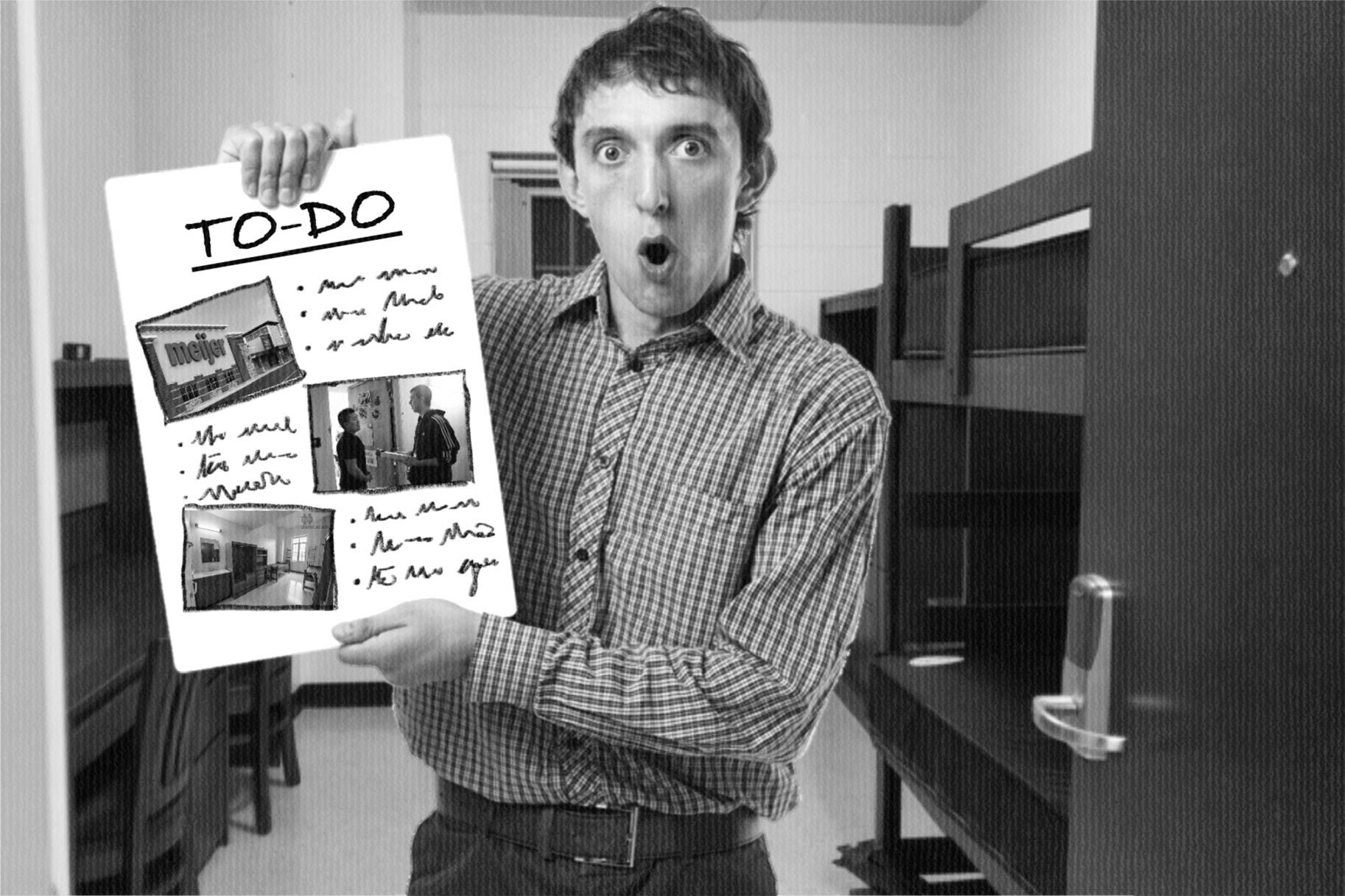
great storage nooks, or you could always try the club lockers in the LaFun basement. Just make sure you don’t skip this step. Nothing kills the vibe like having to fight for space with the coffee table.
3. Acquire some “beverages” I’m going to have to be a bit vague with this section, especially since the Office of Community Standards has been breathing down my neck since an
unfortunate incident last year. Just be aware that if you’re looking for “refreshments,” certain respectable local establishments (Meijer) would be more than happy to provide them. Then it’s just a matter of hauling your new refreshments back to your dorm. Most students I’ve seen tend to use something subtle and inconspicuous, like a large suitcase or moving bag. Surely nobody can guess what’s inside.
4. Find some guests
It’s finally time to start sending out invites. If you have lots of friends, this part is easy. If you have relatively few friends, there are still plenty of ways to make sure your room gets uncomfortably full. You could always try submitting your party to the weekly TheWeek@ND email chain, though I wouldn’t count on it getting approved. As a last
resort, advertising with an AIgenerated poster on Fizz will at least draw a crowd, though I can’t in good conscience endorse this approach.
5. Enjoy your party!
You’ve done it! A successful dorm party is now taking place in your room. Now it’s time to stand back, rest on your laurels and watch the floor get steadily stickier as the night goes on. As host, your job includes keeping the music going, preventing guests from spilling into the halls and stopping light-fingered BP girls from stealing the décor off the walls (the B stands for burglary).
6. Get people out
Now that you’ve successfully thrown your dorm party, an equally monumental task awaits: getting people out. You might start wishing you kept your RA around a little longer. There are a few tried-and-true methods to evicting your room’s new residents, but if worst comes to worst, you might have to cut your losses and accept that you’ll be sleeping in the hallway.
Contact Matthew Rah at mrah@nd.edu
MEG HAMMOND | The Observer
MEG HAMMOND | The Observer
HUMOR
Baraka Bouts wraps up semifinals
By Caloe Peretti Sports Writer
On Tuesday night, Dahnke Ballroom hosted the semifinals of the 23rd annual Baraka Bouts. Fourteen bouts helped decide matchups for the finals to take place in a week’s time. Here’s how each of the contests played out.
Bianca “Chili Guava” Storino def. Anna “NoDelay” Saadeh
In the opening bout of the night, both fighters came out strong, but Storino’s power and endurance ultimately proved too much for Saadeh. Storino dominated early with relentless swings, forcing Saadeh to adjust her pace and stay defensive. Though Saadeh landed several clean hits and showed composure in the ring, Storino maintained control through all three rounds and finished strong to secure the win. Storino won by unanimous decision.
Mallory “Bing Bang” Turner def. Emma “International Hit” Phelan
Turner started with the first hit and kept the pressure on throughout a close, fastpaced fight. Phelan countered with quick, strategic jabs, refusing to back down. Both boxers showcased speed and endurance, trading momentum in front of an energetic crowd. In the final round, Turner pushed Phelan into the corner and controlled the pace until the bell. Turner won by unanimous decision.
Kylie “Sneaky Pizza” Fuerbacher def. Maisie Jenuwine
Fuerbacher and Jenuwine both fought with poise and balance in a technical matchup. Jenuwine opened with the first hit, but Fuerbacher’s quick movement and boband-weave style helped her dictate the rhythm. In later rounds, Fuerbacher increased her offensive pace, forcing Jenuwine to stay on defense. Both gave everything in the final round, drawing cheers from the crowd, but Fuerbacher won by unanimous decision.
Victoria “Southern Belle” Baltz def. Katie “Double Tap” Dobelhoff Dobelhoff opened strong, landing the first hit and setting a quick tempo. Midway through the round, Dobelhoff suffered a shoulder injury that briefly paused the match but returned determined to fight through the pain. Baltz capitalized on the momentum shift, landing steady shots
and maintaining control to the end to take the win by unanimous decision.
Tess “TK-O” Kesler def. Jillian “Red Hot” Skurski Kesler came out aggressive and never relented, controlling all three rounds. Her speed and sharp combinations forced Skurski onto defense early. Despite Skurski’s efforts to rally late, Kesler’s conditioning and crowdbacked energy gave her a decisive edge. Kesler won by unanimous decision.
Eugenia “Guerrera” Rios def. Peyton “Toothless” Nguyen Rios and Nguyen delivered one of the most intense bouts of the night. Nguyen opened fast, pinning Rios to the ropes with quick combinations. Rios answered back in Round two, matching Nguyen’s energy and landing solid counters. The final round saw Nguyen pressing forward again, but Rios’ defense and endurance helped her edge out the split decision win.
Kylie “Countdown” Carney def. Ella “E-squad” Jensen Carney asserted control early, forcing Jensen into a defensive stance in the
opening round. Carney’s quick footwork and consistent offensive pressure continued through all three rounds. Jensen protected well and stayed composed but Carney’s pace and precision secured a unanimous victory.
Kiska “The Hitwoman” Porter def. Avary “Sensei” Serpa
Porter came out swinging with power and aggression, setting the tone from the opening bell. Serpa tried to hold her ground, but frequent stoppages slowed her rhythm. Both fighters showed grit in a physical matchup, though Porter’s strength and control in the clinches gave her the advantage through all three rounds giving her the unanimous victory.
Rosie “The Riveter” Binette def. Lindsey “The Beater” Weeter
Binette and Weeter battled through three high-energy rounds. Binette landed several powerful punches early, while Weeter countered with fast responses. Despite a brief pause due to Binette’s nosebleed in round three, she came back swinging, keeping strong contact until the end. Binette won by unanimous decision.
Faustina “Bear” Barcena def. Maddie “Mad-dawg” Orchard Barcena opened aggressively, landing several quick shots that kept Orchard on the defensive. Both fighters exchanged clean hits through the middle round, showing equal determination. In the final round, Barcena’s speed and footwork helped her finish strong and secure the unanimous victory.
Maribella “The Bomb” Fues def. Maria “Sandman” Souder
Souder started strong, landing a flurry of quick punches, but Fues found her rhythm in the later rounds. Fues responded to Souder’s early attack with powerful counters and steady pressure. After equipment breaks slowed the pace, Fues capitalized on each reset to finish stronger. Fues won by split decision.
Lucy “Alpha” Graceffo def. Lilly “The Linebacker” Nadler Nadler came out swinging with powerful strikes that initially put Graceffo on defense. Graceffo stayed calm under pressure and grew stronger as the match went on. In the final round, she
used her quickness to exploit Nadler’s fatigue, landing sharp and accurate hits to seal the victory. Graceffo won by split decision..
Meghan “The Megalodon” Sharkey def. Marlene “La Dama” Caballero
Sharkey dominated from the start, overwhelming Caballero with relentless speed and precision. Sharkey stayed light on her feet, maintaining control through all three rounds and never allowing Caballero to build momentum. Caballero fought back hard in the final round, but Sharkey’s endurance and power carried her to a unanimous win.
Olivia “The Gentle Giant” Nijim def. Caoilinn “K.O.” Flinn
In the final bout of the night, Nijim and Flinn delivered a thrilling finish to the semifinals. Both fighters traded heavy hits and showed balance between offense and defense. Nijim gained an edge in the closing seconds, landing a series of powerful shots that sealed her victory in a competitive matchup. Nijim won by unanimous decision.
Contact Caloe Peretti at cperett2@nd.edu

GABRIELLA MARTIN | The Observer Two boxers meet each other with confrontational jabs in the center of the ring during the 23rd annual Baraka Bouts in a semifinals bout on
Baraka Bouts final rounds will take place in Dahnke
QUESTION OF THE DAY:
How much caffeine have you had in the past 24 hours?

Nick Dellelce sophomore
O’Neil Family Hall
“400 mg.”

Christina Steinki senior off campus “160 mg.”

Katherine Do sophomore
Pasquerilla East Hall
“Zero.”

TADDIONO | The Observer
Senior KK Bransford drives toward the basket during the women’s basketball matchup against Chicago State on Sunday, Nov. 9. Bransford and the Fighting Irish crushed the Cougars 116 - 58 in their second win.
CROSSWORD | WILL SHORTZ


Azia Koser junior off campus
“Zero.”

Alyson Leal sophomore off campus
“One cup of coffee.”
SOCIAL MEDIA POLL
Have an idea for a poll? Email dstangel@nd.edu
What areas do first-gen students need more support in?
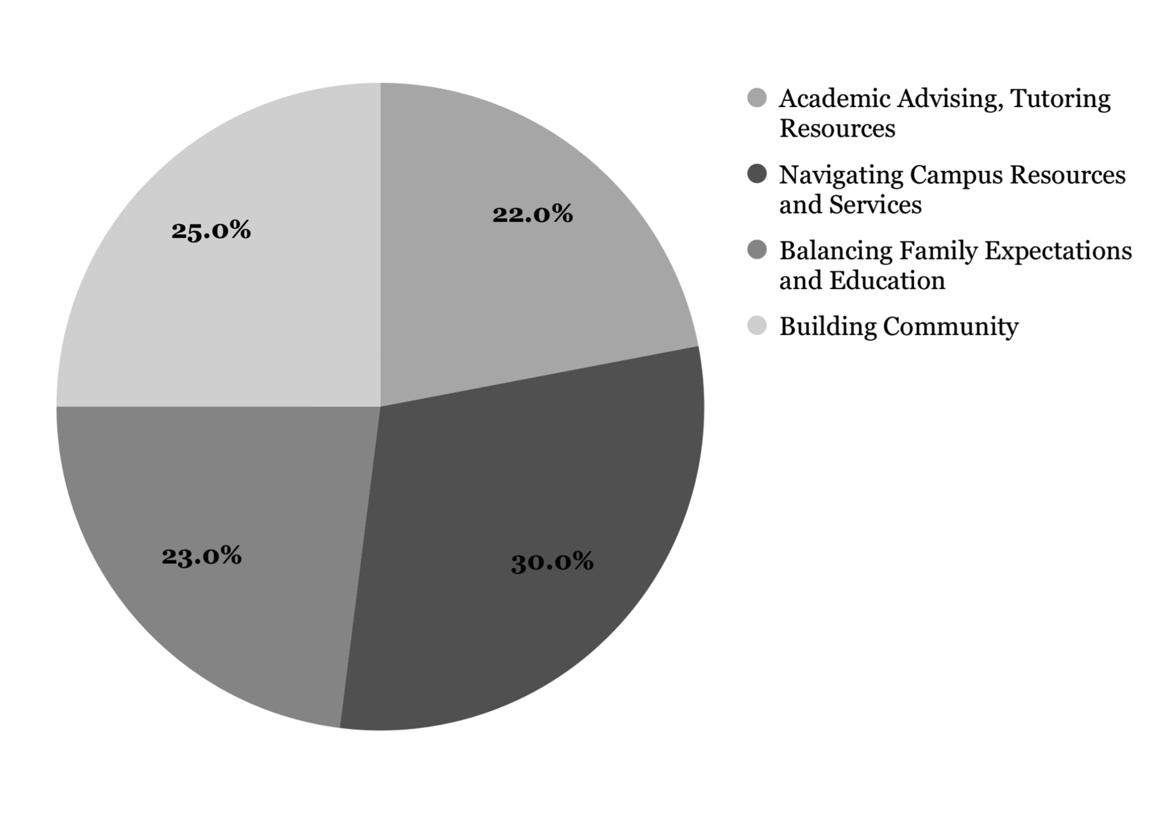
THE NEXT FIVE DAYS
Want your event included here? Email news@ndsmcobserver.com
Wednesday
Hope and Healing lecture
Tom Catena speaks on Catholic faith and work in medicine Eck Center Auditorium
5 p.m. - 6 p.m.
Thursday
“Titus Adronicus”
Performance by the Not-So-Royal Shakespeare Company
Washington Hall Lab Theatre
7 p.m. - 9:30 p.m.
Friday
“Little Shop of Horrors” PEMCo presents fall semester student musical
Washington Hall Mainstage Theatre
7 p.m. - 9 p.m.
Saturday
Notre Dame men’s hockey vs. Michigan State
The Irish take on the Spartans
Compton Family Ice Arena
6 p.m.
Sunday
Magnificat performance: “Lifting up the Lowly” Concert program featuring Bach’s iconic work
Leighton Concert Hall
4 p.m. - 6 p.m.
MARIELLA
PHOTO OF THE DAY
Notre Dame men’s basketball improves to 3-0
By Harrison Brown Sports Writer
The Irish sailed to commanding victories in their first two games, winning two straight by 20+ points for the first time since 2021. In their third and final home game starting off the season, Notre Dame hosted the Eastern Illinois Panthers. Eastern Illinois entered the game with an even record, one win and one loss while the Irish were searching for a third straight win, which they would find.
In the first minutes of the game, the physicality of both teams playing became clear. Three jump balls were called in three minutes and multiple scuffles broke out. Eventually, junior guard Markus Burton scored the first points of the game with a midrange jumper, helping the Irish build an early lead. Burton would lead all scorers in the first half with 12 points.
Both teams experienced shooting woes early. Midway through the first period, the Irish were two for eight on three-point field goals, and the Panthers were zero for four. The missed shots resulted in the Irish lead diminishing as the Panthers went on a quick 7-0 run to take the lead for the first time in the game. The rest of the half was a constant back and forth with nine lead changes in five minutes. The Notre Dame defense stepped up to close out the period, holding Eastern Illinois scoreless for the final 2:40, and went into the locker room with a 31-28 lead.
In the first half, the Irish’s biggest lead was seven, and the Panthers’ was only two.
A large reason neither team was able to build momentum and amass a substantial lead stemmed from the cold stretches beyond the arc. Combined, the two squads went four for 25 on attempted threes. Notre Dame shot just above 15%, a stark deviation from the 47.5% they shot in the first two games of the season.
Coming out of the half, the shooting concerns were rapidly silenced. The first made bucket of the second half was a three from junior guard Braeden Shrewsberry, which was followed by another three from Burton. Shrewsberry’s hot streak would continue, quickly hitting two more threes, including one that he sunk from the logo. In the first five minutes of the second period, Notre Dame already had double the number of makes from deep as they did in the entirety of the first half.
The impact of the improved shooting was felt immediately as the Irish took their biggest lead of the game at 48-36. Notre Dame remained firmly in the driver’s seat, leading 55-42 with half the period left. The physicality of defense also returned, forcing the Panthers to go over nine straight minutes without a made field goal. Notre Dame looked like a completely different team in the second half, outscoring Eastern Illinois 47-30. After a competitive first half, the Irish dominated the second to crush the Panthers 78-58.
Burton was the leading scorer for the Irish last season and through the start of this season. Against Eastern Illinois, his 21 points were the
most of any player. Another bright spot in the Notre Dame victory was Shrewsberry. Shrewsberry provided a spark to reignite a shooting game that had gone cold and overall finished going six out of eight attempts on threes. He has had five or more threes in back-to-back games. Beyond this outstanding volume has been an impressive efficiency as he is shooting 55%
this season. The Irish had a third player finish with double-digit scoring with Jalen Haralson’s 17-point outing. The freshman guard was a perfect six for six from the field and also tacked on five free throws. The game’s leader in rebounds was graduate forward Carson Towt, who recorded 11. Entering the matchup, Towt was third in the nation averaging 14.5
a game. His performance against the Panthers was his third straight of 10+ boards. Next up for the Irish is their toughest test of the season as they travel to Columbus, Ohio, to take on Ohio State. The Buckeyes are also undefeated, mirroring Notre Dame’s record with three straight wins.
Contact Harrison Brown at hbrown23@nd.edu
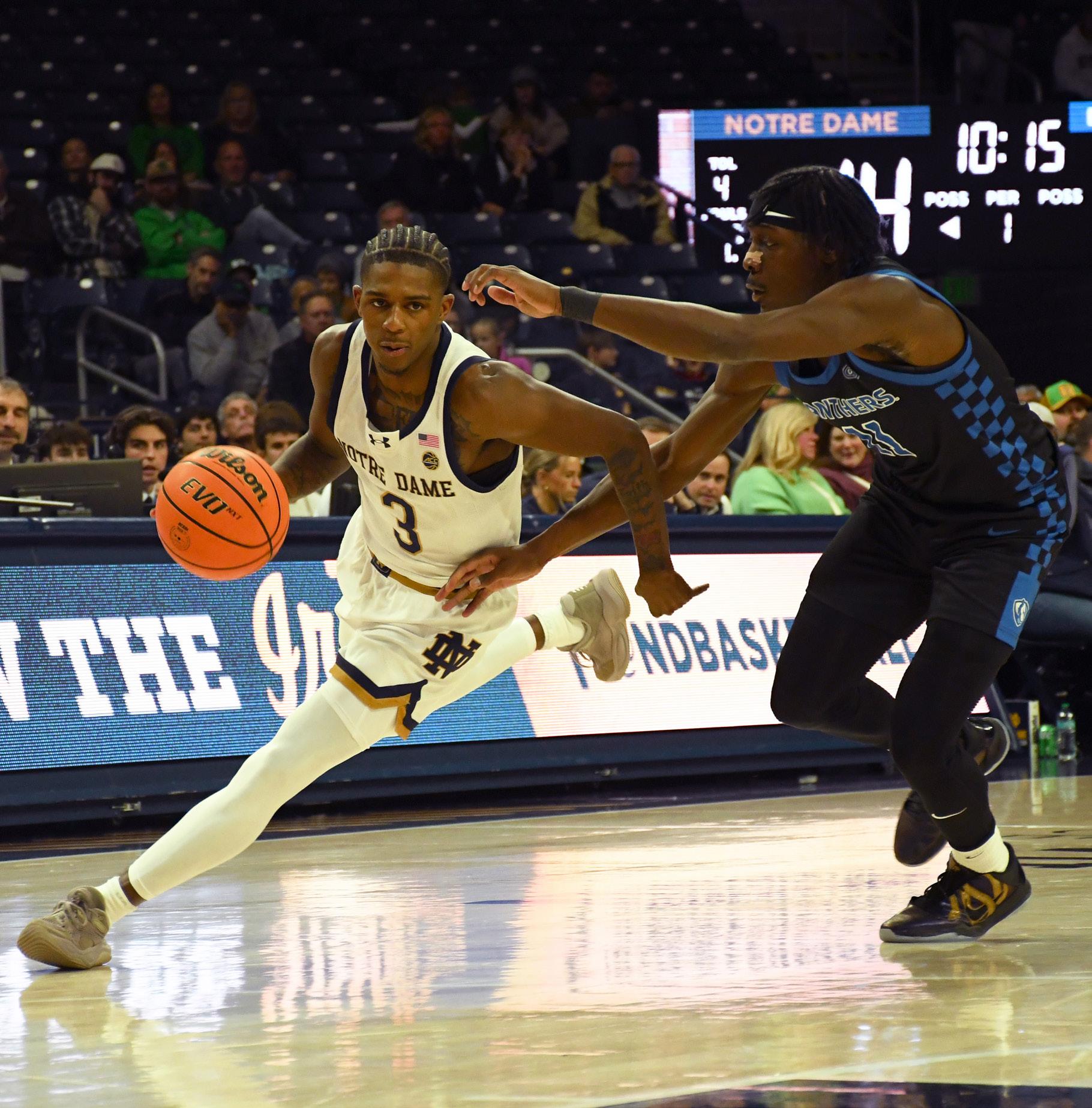
FOOTBALL
Stock up, stock down: Notre Dame vs. Navy
By Payton Dymek Sports Writer
Stock up: CJ Carr
Usually in articles, I will admit to being very cynical about freshman CJ Carr’s performance. However, this week I have nothing but compliments to give. Carr threw for 218 yards, helping lead the Irish offense in three of their touchdowns, while going 13-for-16 on passing. His first touchdown pass came in the back half of the second quarter when Notre Dame was up by 14 points.
Although the possession didn’t start the way the offense had hoped with a negative 3-yard pass, Carr made the decision to let the
running backs drive the offensive line forward. He then thew a 27-yard pass to senior wide receiver Will Pauling, which set up a 5-yard touchdown pass to junior wide receiver Jordan Faison to mark the first Notre Dame throwing touchdown.
Carr’s other two touchdown throws came in the third quarter to sophomore wide receiver KK Smith and junior tight end Ty Washington. This was Smith’s fourth game appearance this season and Washington’s second. Smith’s catch was the only play of that possession, since Navy lost the ball on their 34yard line on a turnover of downs and put Notre Dame up 28-10. Late in the third quarter, backup sophomore
quarterback Kenny Minchey saw time on the field.
Stock up: Jaiden Ausberry
Despite the weak defensive start that we watched during the first two games, Notre Dame defense’s performance has improved significantly since, especially standout sophomore linebacker Jaiden Ausberry’s. Although he has played in every game this season, totaling 41 tackles, his Navy game was his best performance so far with eight total tackles, three solo tackles, five assists, his second sack of the year and forcing one fumble. Despite his small impact on the stats sheet before this weekend, it’s important to note his impact during the matchup against
the Midshipmen and keep an eye on him as the Irish close out regular season play.
Stock up: kicking
Last week’s performance against Boston College left much to be desired in terms of kicking game, missing two extra points and a field goal. However, freshman kicker Erik Schmidt had a perfect six-for-six performance against Navy, which was extra impressive given the slippery and cold conditions the teams had to play in.
Stock down: remaining schedule and snow
Notre Dame only has one more home game in the regular season, where it will face off against Syracuse in
snowy conditions on Nov. 22. However, for both this game and next weekend at Pittsburgh, the snow will have no effect since no competitor schools are new to the snow. Differently, Notre Dame’s away game at Stanford during Thanksgiving weekend will be the team’s moment in the sunlight as Palo Alto’s sun welcomes the Irish.
The Irish matchup against Pitt will be an interesting watch since both teams are 7-2, but the Irish’s games against Syracuse and Stanford will be great opportunities for the team to improve their playoff ranking statistics. Contact Payton Dymek
GRAY NOCJAR | The Observer
Junior guard Markus Burton flashes past Eastern Illinois Panther defender in the Joyce Center in South Bend on Tuesday, Nov. 12. Burton tallied 21 points and three assists in the third consecutive, 78-58 Irish win.
Notre Dame offensive grades: Navy
By William Cahill Sports Writer
Coming off a somewhat middling offensive performance in last week’s 25-10 win over Boston College, freshman quarterback CJ Carr and the Notre Dame offense were back humming again as they handled Navy 49-10 in a decisive victory. This was more characteristic of the performance one has come to expect from a Notre Dame offense that ranks top 15 in the Football Bowl Subdivision in total offense. This was a dominant return to form for the Irish, but for now, let’s focus on how each facet of the offense fared this Saturday.
Quarterback
Carr pitched a clean sheet, doing exactly what was needed of him to secure the win. He finished with completing 13 of 16 passes for 218 yards and three touchdowns. It was hardly his most impressive stat line, considering he has cleared 300 passing yards multiple times this season, but with Notre Dame’s domination across the board, that kind of performance was not required of him. Carr went downfield early and often,
connecting with senior wide receiver Malachi Fields and sophomore wide receiver KK Smith for multiple key chunk plays of over 20 yards. He remained poised and calm in the pocket as he has for much of the season, despite his limited experience. The downfield passing game seems to be staying unlocked for the Irish, and Carr is at the center of that. Overall, with the same number of incompletions as touchdowns, and general clean play across the board, Carr impressed once again in his ninth start.
Junior Kenny Minchey also got an opportunity for play as the Irish kept pouring it on. He led the Notre Dame offense on its final two series, completing all three passes for 35 yards, including a nice 24-yard completion to freshman tight end Jack Larsen. Minchey looked poised and comfortable in his limited chances, rounding out a quality performance by the Notre Dame quarterback room.
Weekly grade: “A.” Season grade: “A-.”
Running back
This game was defined by quality running back play
across the board for the Irish. Jeremiyah Love once again finished with over 100 yards from scrimmage, 97 of which came on the ground, and two rushing touchdowns. Love leads the Football Bowl Subdivision in touchdowns with 16 through nine games. He has been the beating heart of the Notre Dame offense all season, just as he was last year, and he is continuing to impress with his incredible athleticism and body control.
The most impressive play of the day was Love’s 48-yard touchdown run, where he was dragged down on top of a Navy defender and rolled his body over the defender, landing on his feet and running the whole way to the end zone. Additionally, junior Jadarian Price added another rushing touchdown, his ninth of the season, and in Notre Dame’s final touchdown drive, sophomore Aneyas Williams broke off an impressive 54-yard touchdown run. The Notre Dame running back room continued to impress this week, playing dominant physical football through South Bend’s first snowfall.
Weekly grade: “A+.” Season grade: “A+.”
FOOTBALL
Wide recievers
The long passing game was firmly established this Saturday for the Irish, as three receivers had catches of more than 20 yards. Fields had an impressive showing again, with four catches for 97 yards, demonstrating his body control and strong catching ability downfield. Additionally, Smith recorded two catches for 29 yards and a touchdown alongside junior Jordan Faison, who added four catches for 27 yards and a touchdown of his own. The Irish wide receiver group demonstrated their depth this week, as five different receivers caught passes on Saturday. This was a strong demonstration of Notre Dame’s vast downfield capabilities, which played a significant role in the dominant victory of the Irish.
Weekly grade: “A.” Season grade: “B.”
Tight ends
Perhaps the quietest of Notre Dame’s offensive position groups, tight ends only recorded two catches for 28 yards on Saturday. However, they still played their usual significant role in the
dominant rushing attack, laying down key blocks and staying disciplined. Junior Ty Washington netted the Irish their first red zone touchdown by a tight end this season. Overall, it was a subtle performance by the tight end room this week, but a quality one nonetheless.
Weekly grade: “B.” Season grade: “B+.”
Offensive line
The Irish dominated in the trenches this week, stifling the Navy front seven to no sacks and only two tackles for loss. The rushing attack was powerful and decisive once again, largely due to the quality of blocking up front. The Irish averaged 6.6 yards per rush on 38 attempts, which is a very respectable number. It was the line’s quality pass protection that allowed for such an explosive downfield passing attack. Ultimately, the front of the Irish offense was incredibly impressive throughout.
Weekly grade: “A.” Season grade: “A.”
Contact William Cahill at wcahill2@nd.edu
Notre Dame defense and special teams grades
By Jack Muething Sports Writer
Notre Dame played one of their best games of the season last Saturday as they beat a solid Navy team 4910. Coming into the game, there were questions about Notre Dame’s ability to defend a Navy team that runs an incredibly unique offense. However, the Irish answered any questions with a great performance, showing this is not nearly the same defense the team started the year with. Today, we grade each defensive group’s performance from their win over the Midshipmen.
Defensive line
The defensive line was needed a lot during the game, and they did a solid job limiting this unique Navy offense. When a team runs a tripleoption style offense, it’s the job of the defensive line to stop the play before it gets to the second level. It was mostly the linebackers doing the tackling, but the defensive tackles quickly closed most of the holes up the middle and forced plays to the outside where the linebackers and cornerbacks could make the
tackles.
The line had a big task against this Navy offense that was going to be a run-heavy squad, and they allowed 206 rushing yards. Against any other team, that would be mediocre at best, but Navy averaged 317.3 rushing yards per game coming into the week. So, holding them to 206 is actually a very solid accomplishment. Again, the stats of the defensive linemen are not often going to look very flashy when a team has a run-heavy offense, but when a defense holds an offense to 10 points and a total of 227 yards, you are doing something right.
Weekly grade: “B+.” Season grade: “B.”
Linebackers
Against Boston College, the star of the linebackers was junior team captain Drayk Bowen. Against Navy though, sophomore Jaiden Ausberry was everywhere for the Irish, picking up eight total tackles and two tackles for loss, including one in the third quarter where he sacked quarterback Braxton Woodson for an 11-yard loss in addition to forcing a fumble on the same play. Woodson ended up
recovering his own fumble, but it was still a high impact play by Ausberry and one that ended up being a drive killer. Everyone talks about No. 4 on the offense being such a high impact player, and obviously no one disputes that. However, No. 4 on the defense has been an incredibly underrated part of this linebacker group, and he led the way for the Irish defense in containing their unique option-style offense. Bowen and sophomore Kyngstonn Viliamu-Asa also contributed five tackles each for the Irish. True freshman Madden Faraimo also contributed four tackles coming off the bench. The linebackers were a huge part of stopping the run, and even though it wasn’t their most flashy game of the year, it’s hard to find much to criticize about their play on Saturday. Weekly grade: “A-.” Season grade: “A-.”
Secondary
The quarterback for Navy the entire year has been Blake Horvath. However, he didn’t end up playing on Saturday due to injury, leading to backup Woodson getting the start. Had Horvath played, he would not have
thrown the ball much, but Woodson threw the ball even less than Horvath most likely would have, only having eight passes. Woodson only completed three of those for 22 yards. That’s the lowest mark Navy has thrown for all year, and it isn’t particularly close. Additionally, senior cornerback DeVonta Smith and freshman safety Tae Johnson also made some important tackles during the game, Smith picking up five and Johnson picking up four.
Notre Dame came into the week leading college football in interceptions with 16, but they were unable to force one against Navy, only the second game this year where the Irish have failed to do so. However, when the opposing quarterback only throws eight passes, that’s not exactly surprising. The defense wasn’t asked to do much, but on the rare occasions that Woodson dropped back, the Irish defense locked down. That was huge in leading to the dominant win the Irish had.
Weekly grade: “A.” Season grade: “B.”
Special teams
This week was certainly an
improvement from the Boston College game. The starting kicker for the Irish was true freshman Erik Schmidt, and Irish fans were going to be monitoring his performance very closely. He wasn’t asked to kick any field goals, but he ended up needing to kick seven extra points. He did his job, knocking all of them through without much drama. There are still some questions to be answered as Schmidt wasn’t asked to do too much this week and hasn’t converted on a field goal yet this year, but this game certainly was an improvement from the contest against Boston College. Weekly grade: “A.” Season grade: “B-.”
Additionally, every group gets a boost to their letter grade because there were no penalties committed by Notre Dame that game, the first time the Irish have done so since 1997. The defense played one of their best games of the year on Saturday, and they will look to keep that momentum heading into a ranked matchup against Pitt this upcoming weekend.
Contact Jack Muething at jmuethin@nd.edu
Baraka Bouts junior captains on preparation
By Claire Watson Associate Sports Editor
As snow falls and temperatures drop in early November, Baraka Bouts captains juniors Rosie Binette and Kiska Porter stay active, leading young women and competing in the 23rd annual Baraka Bouts competition.
Binette, who studies neuroscience on a pre-med track with a minor in poverty studies, spoke to the mission of Baraka Bouts and what the club stands for.
“My specific role as captain is the mission’s captain,” Binette said. “In this position, I work on connecting Holy Cross Missions representatives to the club, lead weekly TED Talks about Holy Cross Missions and most importantly, make sure that our club and everyone connected to the club knows what it really means to box for Notre Dame and why we continue to support this larger purpose.”
But that is not all the club stands for. Baraka Bouts also focuses on both the intensity of boxing and the serenity the sport can bring. Porter, a Breen-Phillips resident from Columbus, Ohio, with a major in anthropology and a minor in international security studies, discussed her role as practice captain.
“As a junior captain, I am the practice captain, so I plan the day-to-day workouts for the team,” Porter said. “I incorporate lifting, yoga, some active stretching [and] hip workouts.”
The team also incorporates high-intensity workouts into their training. Beyond practice, the captains prepare for performance in the ring differently.
“Before entering the ring, I like to listen to music, spend some time alone and reflect on the season in order to prepare for the night ahead,” Binette said. “I’m a very outgoing and social person, so I’m usually always around people, but in the time before I compete, I like to center myself because I know that it is just going to be me alone in that ring.”
In contrast, Porter takes a more strategic and deeper thinking method.
“I always tell everybody in the club that boxing is like physical chess,” Porter said. “It’s more like chess than any other physical sport. You have to go into it thinking about your game plan and your strategy.”
Porter further discussed using visualization as preparation.
“It’s not about who’s the strongest, who punches the hardest,” Porter said. “When I go into a bout, I map that
out in my head, what I’m good at and what I need to do to combat any obstacles in my face ... win or lose, I gave it my best.”
While the juniors personally prepare, they also help new boxers in the club, no matter their year. Both captains emphasized the pride they feel for these new boxers.
“I’d just say how proud I am of them,” Binette said.
“It takes so much courage to step into the ring in front of so many people you know and don’t know and compete individually. It sounds cliche, but regardless of the outcome, I’d say that they proved so much more than any determination of a winner in the ring could ever prove. By stepping into the ring, not only are they supporting children’s education abroad, but they’re also inspiring everyone watching,
from little girls to their roommate, to step out of their comfort zone and try something they might love.”
Porter added on to Binette’s sentiment.
“I would tell any other class to really appreciate that experience, it’s unlike any other,” Porter said. “And again, win or lose, you tried your best, and you grew so much throughout this season. You came to practice. You were so
dedicated to practice every day, you really did take the time to gain a lot of encouragement and wisdom, and you met a bunch of girls, and looked at all the friends that you made along the way.”
The Baraka Bouts finals will take place in Dahnke Ballroom on Nov. 18 starting at 7 p.m.
Contact Claire Watson at cwatson7@nd.edu
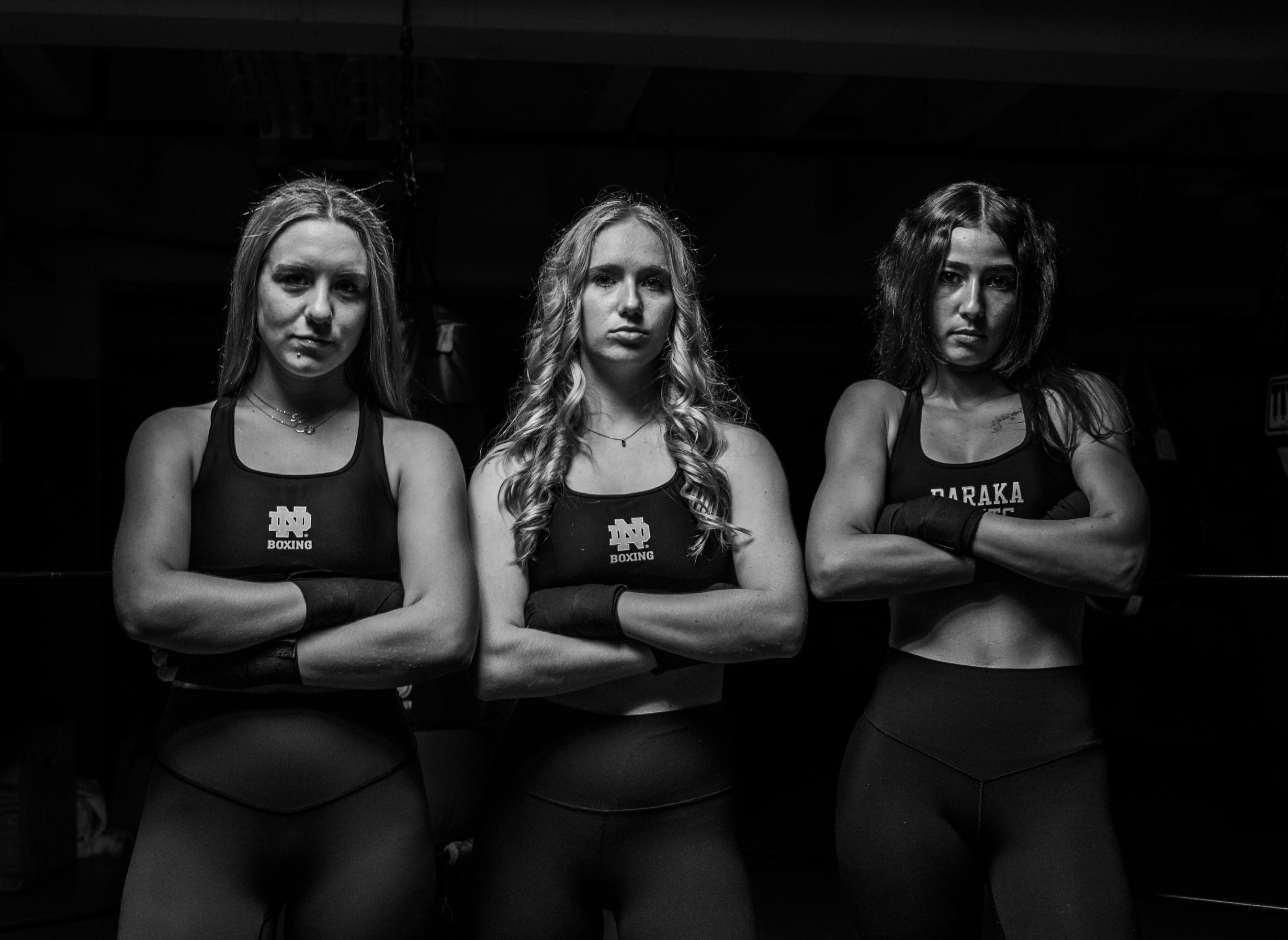

Courtesy of Zoe Keane
From left to right, Rosie Binette, Kylie Reese and Kiska Porter stand together; Binette and Porter are the junior captains for this year’s 23rd annual Baraka Bouts. The duo has put an emphasis on the club’s charitable purposes, growth of relationships and participant empowerment.
BARAKA BOUTS
Boxers improve technique, grow in community
By Payton Dymek Sports Writer
As boxers took to the ring for the Baraka Bouts semifinals Tuesday evening, senior captain Ocean Leto reflected on the intense training boxers go through to prepare for their fights and her own role in producing this year’s Baraka Bouts.
Baraka Bouts has meant much more to Leto than just her wins and training; she explained how much growth she has seen in the club and its impact abroad in Uganda, where the money raised from the Bouts goes. “[It’s] really neat seeing how our awareness and fundraising has helped build real buildings like their dining hall and dormitories and tracking updates on how the girls like their new amenities during Missions Monday,” she said. Aside from looking at the impact of the club overseas, Leto has seen tremendous change within the club itself, especially how members’ confidence and excitement increase when they learn a new skill, which she says is “the essence of Baraka Bouts.”
As one of the technique captains, Leto guides the women in most of their movement training, which Leto described as “the first line of defense.”
“Knowing the stance, how to move and how to distribute your weight are the points of focus,” she said. From there, the captains teach jabs, crosses, blocks and hooks. The first hour of each practice is spent on cardio or calisthenics exercises, while the second hour focuses on technique.
Outside of boxing, Leto
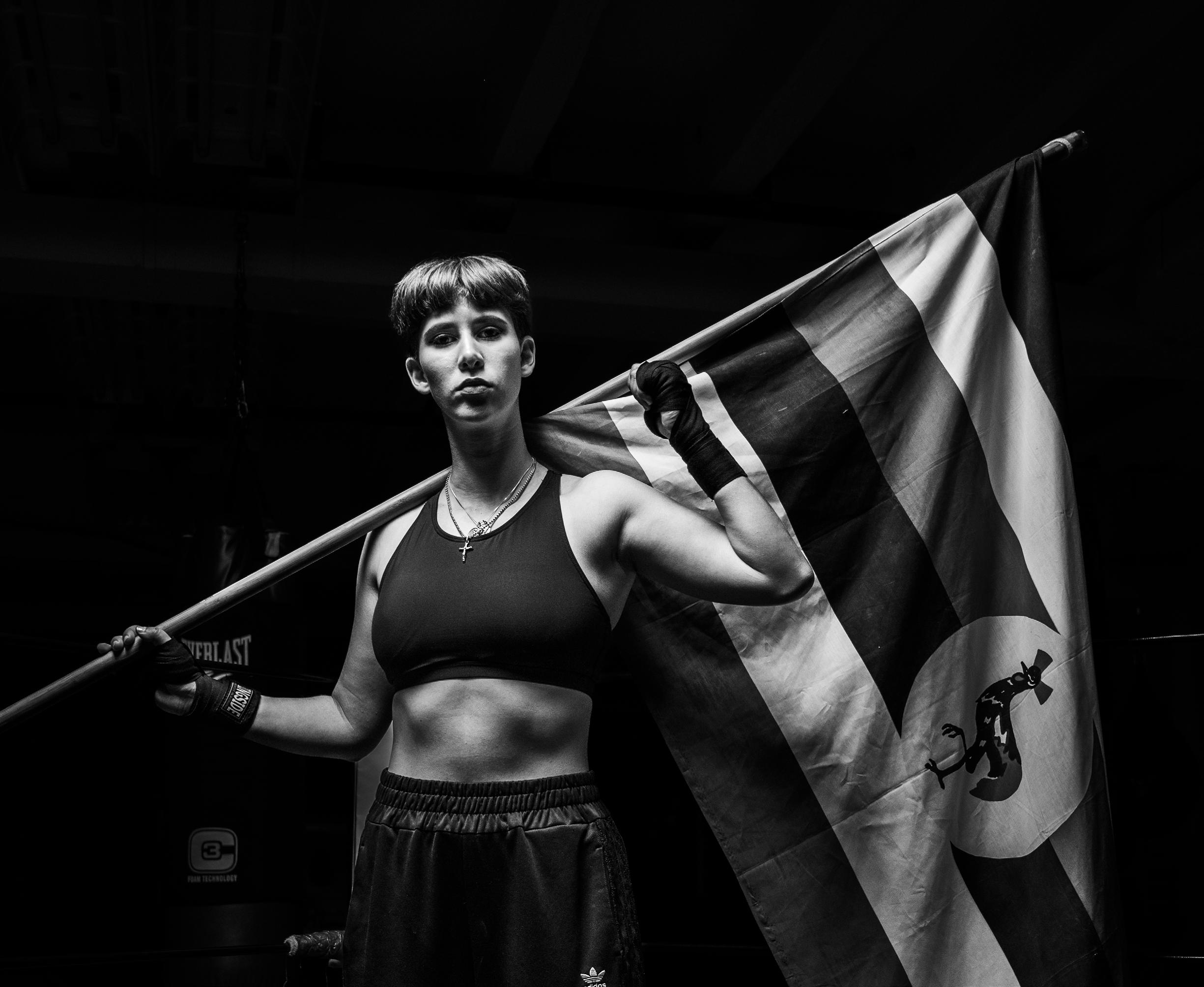
said her fitness comes from training with the Navy ROTC Program and running with a weighted vest when the weather is nicer. Despite the grueling training Leto puts herself through, she keeps coming back because of the club’s “kinetic art, the call
PAID
for discipline and its competitive mirth. It’s a beautiful sport that also empowers your means and agency of self-protection.”
Leto explained that it’s normal for students to join the club with no background in boxing, since the training is
meant to teach everyone from the ground up skills that will stick with them throughout their lives. Leto said there are more freshmen in the club this year than ever before; however, the team dealt with struggles encouraging new boxers to spar for the first time and in participating in the tournament early on. These anxieties disappeared as the season went on, and Leto saw more people wanting to compete, which she described as “a good sign for the future of the club.”

For those who are hesitant to box, Leto offered some advice. “I say be bold and give it a go, because there’s no other feeling than working under that pressure and playing tag in the ring,” she said. “Even if you feel like you’re not that type of person or if you feel like you’re not athletic enough, try it, and I guarantee you’ll take away something rich.”
Leto, making the most of her final Baraka Bouts, is enjoying her final moments with the girls and coaches in the club and reflected on how it’s “been a joy growing in friendship, especially [with] the captains, and improving technique.”
The Baraka Bouts final rounds will be hosted on Nov. 18 at 7 p.m. in the Dahnke Ballroom, where proceeds will go to Congregation of Holy Cross to aid the expansion of schools in Uganda.
Contact Payton Dymek at pdymek@nd.edu
Courtesy of Zoe Keane
Baraka Bouts senior captain, Ocean Leto, holds the Uganda flag over her shoulder. Baraka Bouts has been hosting its annual boxing tournament since 1997 and supports funding for schools in Uganda each year. As a captain, Leto works to craft and guide the club’s movement training.
BARAKA BOUTS
VPs foster community in South Bend and Uganda
By Ben Hicks Associate Sports Editor
Since its inception in 1997, Notre Dame women’s boxing, also known as Baraka Bouts, has developed into the University’s largest all-female organization. Each fall, hundreds of women endure blood, sweat and tears within the ring, not only for their own individual growth, but for the betterment of students at two Holy Cross secondary schools in Kyembogo and Jinja, Uganda. This vigorous pursuit of community-building is spearheaded by a team of experienced upperclass leaders, including senior vice presidents Emma Hazel and Tess Kesler.
A hometown kid from South Bend, Hazel studies political science and Spanish at Notre Dame. As vice president, she oversees the club’s mission operations and fundraising efforts with alumni. She was initially drawn to the service aspect of the group, advocating for a role in organizing
the mission work when she became a junior captain. “You join boxing and then you’re told, ‘Oh, you’re also helping to spread Catholic education in Uganda,’” she recalled.
Hazel has a unique tale, one that even surprised Kesler, for how she stumbled upon boxing. Donning her Pasquerilla West Hall merch, the thenfreshman Hazel was perusing a local Target when a Baraka Bouts coach approached her and introduced the club. “I heard his pitch and I thought, ‘this is the coolest club in the world. I have to be a part of it.’ So I went to the first practice and I’ve loved it ever since.”
Kesler is also a political science major with a minor in Italian. The New Jersey native became involved with boxing during her freshman year, with some encouragement from her resident assistant in Walsh Hall. “She was really plugging it to all of the freshmen to try to get us to come for the first practice. I really looked up to her as she was one of the first people I met at
Notre Dame. I just kept coming back year after year because I love that community,” Kesler said.
In her role as vice president, Kesler coordinates the eight two-hour practices each week, working in conjunction with volunteer coaches to lead technique practices and a cardio regimen. Drawing on her admiration and appreciation for previous captains, Kesler said she has “tried to be creative with thinking how we can incorporate more strength exercises to make practices more intentional.”
Aside from their instrumental work in fundraising for Lakeview and St. Joseph’s Hill educational services, the two vice presidents have been fulfilled by mentoring inexperienced boxers. “You get to see a lot of novices, who really doubted themselves at the beginning of the season, put in all this work and then finally compete. When they finally do, a lot of them will have smiles on their faces after and be really proud of themselves.
So I think the best part for me is just getting to see that journey,” Kesler said.
Hazel has had similar experiences in her mentorship, saying, “When you’re cornering the same girls over and over and when you see it finally work in the ring, and they just come back and they’re beaming, it’s the most exciting thing in the world to watch.”
She also emphasized the difficulty of embracing a new challenge and how the culmination of the tournament each year shines the spotlight on the hours of work spent by young boxers improving footwork, hand placement and confidence.
That diligence isn’t practiced in solitude, with companionship and community being the lasting impact of both Hazel and Kesler’s time in the club. Kesler cited the guidance displayed by captains during her freshman year as helping grow her love for the sport. “Those are the kind of people I’ve been trying to emulate now that I’m in a
leadership position. I want to have that same impact on the younger girls. It’s just the biggest family,” Kesler said. For Hazel, it was her firstround tournament matchup as a freshman that revealed the geniality of Baraka Bouts, despite the combative nature of boxing. “She didn’t go easy on me at all but she was just the most reassuring person, telling me to go out there and know what I was capable of. Then my sophomore year, I was able to work with her and just keep in touch after the club. She’ll donate to my page every year, and we’ll talk all the time. I was able to gain a friend through a mentor.”
Following last night’s semifinals, the 2025 edition of Baraka Bouts will conclude next Tuesday, Nov. 18. The finals will begin at 7 p.m. inside Duncan Student Center’s Dahnke Ballroom, with tickets available for purchase online and from a boxer.
Contact Ben Hicks at bhicks2@nd.edu
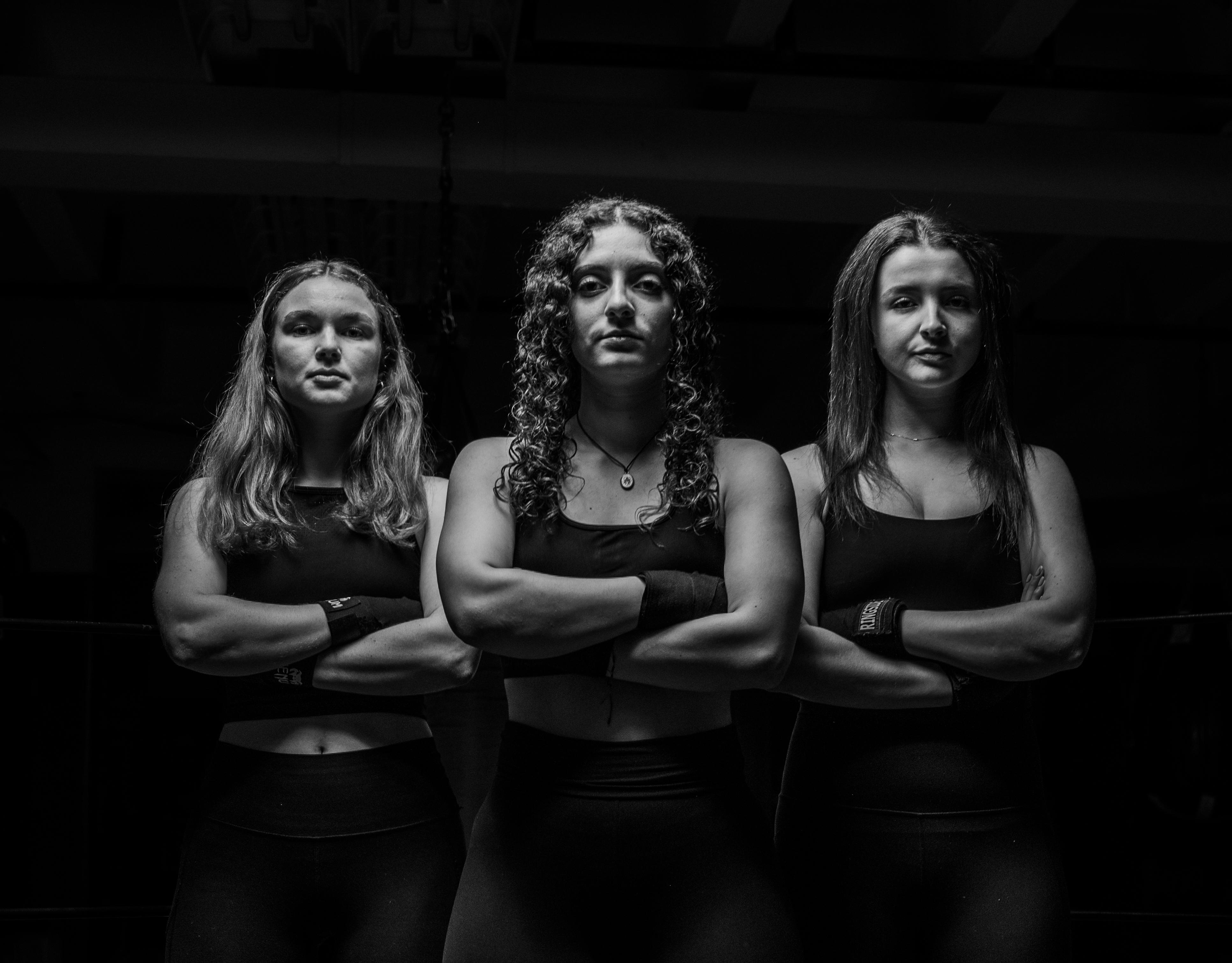
Courtesy of Zoe Keane
From left to right, Baraka Bouts boxers Tess Kesler, Layann Wardeh and Emma Hazel stand together; as senior vice presidents, Hazel and Kesler guide this year’s Baraka Bouts participants, emphasizing the club’s larger purpose of community-building and service. Hazel and Kesler bring their group to the 2025 Baraka Bouts finals on Tuesday, Nov. 18.
